Carl Beeston Gow of Palm Beach - Gallipoli Veteran
21st of March 1889, born at Newcastle - 29th of October 1970 passed away at Mona Vale Hospital, Mona Vale
One resident who returned here to serve others in any capacity he could for all of his days and even after he passed away on October 29th, 1970, was Carl Gow of the Gow-Gonsalves boatshed at Palm Beach.
Carl was a founding member of the Palm Beach RSL Club, which held services at Whale Beach (dawn) and at the Palm Beach RSL cenotaph (11am) again this year.
Carl served at Gallipoli and in France during WWI, returning an honorary Captain to Palm Beach to set up a store with fellow veteran Reginald Augustus Howlett, as well as work as a fisherman, boat hire shed and would set out to rescue others from the Gow's - Gonsalves boatshed, still in existence just north of the Palm Beach ferry wharf. In fact, the first 'Palm Beach RSL' commenced in the Gow-Gonsalves shed itself.
Born Carl W J Beeston Gow at Newcastle in March 1889, the youngest son of Robert and Mary, his father was of the Pilot station at Newcastle. Carl was from a family whose contributions to saving lives in Australia, either as engineers on vessels, as Pilot Station attendees, as Lightkeepers at NSW Lighthouses, and as men who went out in their vessels to save others, could fill volumes.
Palm Beach is still littered with traces of Carl; the first Palm Beach Lands Company jetty became Gow’s wharf and the boatshed, now of the Gonsalves family, remains a thriving business, Gow’s, his elder brother David Robert William and his father Robert, worked as a relieving and second lighthouse keeper at Barrenjoey Lighthouse from 1912 to 1919. While the ship’s wheel from the Helen B Stirling, once in the foyer of Club Palm Beach (Palm Beach RSL), was a gift from Carl Gow.
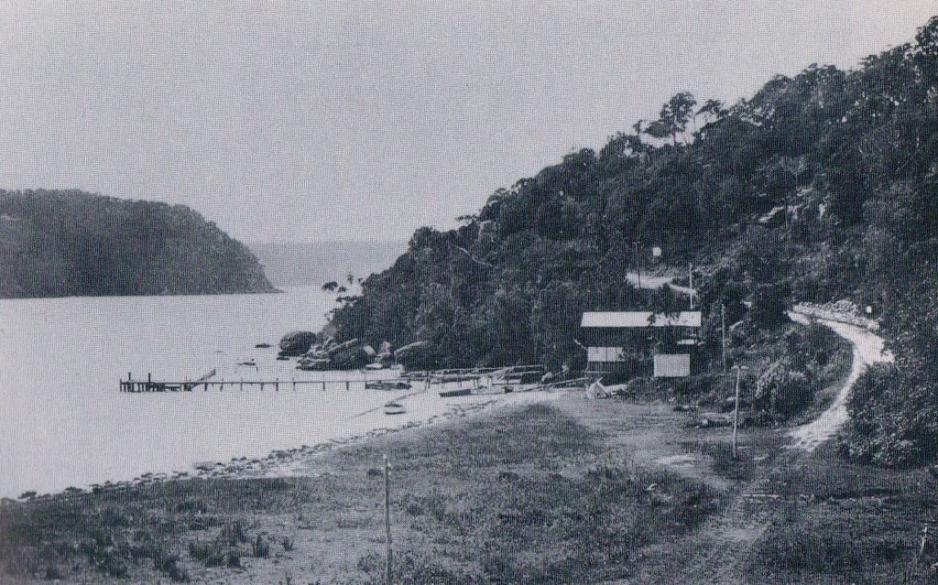
Gow's jetty was link with the outside world for visitors to Palm Beach - this image circa 1920-21. Courtesy Peter Verrills.
Carl was awarded a Military Cross as a result of his service in WWI, and went in a private and came out a an Honorary Captain.
Carl was wounded at Gallipoli but remained on duty for two days until sent to hospital. He then went on to serve on the Western Front, took the opportunity to visit Paris when on leave, and just ‘got in with it’ when he finally came home.
Signing up on May 28th, 1915 in Liverpool NSW as news of what had happened at Gallipoli broke at home, he gave his employment as Mail Order Manager or ‘Under Manager’.
Just over two weeks later, on the 16th of June he was embarking on HMAT Karoola A63 as part of the 6th Reinforcements of the 3rd Battalion AIF (New South Wales) [1st Infantry Brigade]. The Karoola was one of a fleet of transport ships leased by the Commonwealth government for the specific purpose of transporting the various AIF formations to their respective overseas destinations. His Majesty's Australian Transports (HMAT) were also detailed to carry various commodity exports to Britain and France. The fleet was made up from British ships and captured German vessels.
The HMAT A63 Karoola weighed 7,391 tons with an average cruise speed of 15 knots or 27.78 kmph. This vessel was owned by the McIlwraith, McEacharn's Line Pty Ltd, Melbourne, and manned by Australian officers and crews, part of our newly formed RAN. The Karoola was leased by the Commonwealth until June 1919.
Carl was allotted – 3 blankets, 1 waterproof, 1 jacket/tunic, 1 pair dungarees, 1 Whity hat, 1 pair of boots, 2 singlets but no socks.
Mr Gow was assigned to the 3rd Battalion. The 3rd Battalion was among the first infantry units raised for the AIF during the First World War. Like the 1st, 2nd and 4th Battalions it was recruited from New South Wales and, together with these battalions, formed the 1st Brigade.
The battalion was raised within a fortnight of the declaration of war in August 1914 and embarked just two months later. After a brief stop in Albany, Western Australia, the battalion proceeded to Egypt, arriving on 2 December. The battalion took part in the Anzac landing on 25 April 1915 as part of the second and third waves and served there until the evacuation in December.
In August, this battalion took part in the attack on Lone Pine.
Carl survived this battle but on the 21st of August 1915 he was wounded. His records state he remained on duty - 'Wounded MFC', meaning 'Mortar Fire Controller' is next to this notice in his War Records. On the 23rd of August he was sent to hospital and on the 24th was transferred to Mudros as a result of his wounds and admitted into the 1st Australian Casualty Clearance Station there.
Mudros is a small Greek port on the Mediterranean island of Lemnos. It was utilized during World War One as a base from which to launch the Gallipoli campaign as the Allies attempted to seize control of the Dardanelles Straits, some 50km away. There is a cemetery there in which fifty Australians are buried.
His father had this to say about his being wounded so soon after being deployed:
PRIVATE CARL GOW.
Mr. Robert Gow, of East Newcastle, has recieved an intimation from the Defences Department, that his son, Prtvate Carl B. Gow, had been wounded at the Dardanelles. In forwarding the information for pubIication, Mr. Gow says:--
"I may state he enlisted in June last, and was only one weekend in camp, when he left with the 6th Reinforcements of the Third Battalion, on 16th June, arriving In Egypt on 17th July. He spent only seven days in Egypt, and then went to the front.
He never had a day's training In his life, and I think greater care should be taken, not to allow untrained lads to go straight into the fighting line, no matter how keen their desire to get there may be.
Before he enlisted, my son was employed at Winn and Company's, Oxford-street, Sydney. He was in charge of their country order department. He had been with Winn and Company since he was fourteen years of age. He is now 20. PRIVATE CARL GOW. (1915, September 14). Newcastle Morning Herald and Miners' Advocate (NSW : 1876 - 1954) , p. 5. Retrieved from http://nla.gov.au/nla.news-article137969100
Tall al Kebir or Tel-el-Kebir ('great mound') is 110 km north-north-east of Cairo and 75 kilometres south of Port Said on the edge of the Egyptian desert at the altitude of 29 m. During the Gallipoli landings and the Sinai and Palestine Campaign of the First World War, Tel el Kebir was a training centre for the First Australian Imperial Force reinforcements, No 2 Australian Stationary Hospital, and also a site of a large prisoner of war camp. Some 40,000 Australians camped in a tent city at Tel-el-Kebir of six miles in length. A military railway was eventually constructed to take troops from the camp to their vessels in Alexandria and elsewhere for embarkation.
The Tel-el-Kebir village was described by an Australian soldier in 1916 as 'a very dirty little place with a few dirty shops in it'
An Allied War Memorial Cemetery is situated about 175 metres east of the railway station and the Ismailia Canal. The War Memorial Cemetery was used from June 1915 to July 1920, and was enlarged after the Armistice with many graves being transferred in from other temporary interment sites. The camp was converted for use as a holding camp for refugees fleeing the Russian Civil War from what used to be southern Russian Empire.
On the 19th of February, 1916 Carl Gow, along with what was left of the 3rd Battalion, was transferred to the 55th Battalion. The 55th Battalion was raised in Egypt on 12th of February 1916 as part of the “doubling” of the AIF. Half of its recruits were Gallipoli veterans from the 3rd Battalion, and the other half, fresh reinforcements from Australia.
The Australian War Museum states:
‘Reflecting the composition of the 3rd, the 55th was predominantly composed of men from New South Wales. The battalion became part of the 14th Brigade of the 5th Australian Division.
Arriving in France on 30 June 1916, the battalion entered the frontline trenches for the first time on 12 July and fought its first major battle at Fromelles a week later. The battle was a disaster, resulting in heavy casualties across the division. Although in reserve, the 55th was quickly committed to the attack and eventually played a critical role, forming the rearguard for the 14th Brigade’s withdrawal. Despite its grievous losses the 5th Division continued to man the front in the Fromelles sector for a further two months.
The Australians were given a gradual introduction to the Western Front fighting conditions. It was a new experience for them. They trained with some of the latest weapons of modern warfare including poisonous gas. Things became more serious when they moved into the front line trenches in a section around Armentières which had been dubbed "the nursery".
Meanwhile the British army, under Sir Douglas Haig, was about to conduct a mighty offensive in the Somme region, 100 km away to the south. The battle was set for 1 July, and it would continue for five months. It began disastrously; there were 58,000 casualties on the first day and little ground was taken. As the fighting went on three Australian divisions, the 1st, 2nd and 4th Divisions, were eventually drawn in, leaving the 5th Division under Major General James McCay, behind. This newly arrived 5th Division would be the first to see heavy action.
Just beyond the line held by the Australians in the nursery sector was the shell-damaged village of Fromelles standing on a strategically important ridge behind the German front line. The surrounding battlefield had been fought over by the British during 1915, and now a fresh attack against the ridge was planned. It was hoped that a strong diversionary attack here would prevent the Germans sending troops to reinforce their defences on the Somme. The attack was set for the evening of 19 July and the Australians and another untried British division, the 61st, were chosen to make the effort.
The attacking troops were not familiar with Fromelles itself because it was in German hands; for them the nearest village was Fleurbaix which stood behind their own lines. For a long time afterwards many would refer to the events about to unfold as the battle of Fleurbaix, but eventually the name of Fromelles stuck and today it is by that name that the battle is known.
On this battleground the opposing trench lines faced each other across a flat, boggy and overgrown no man's land criss-crossed with drainage ditches and a small stream. Because of the high water table, the trenches were mostly above-ground breastworks. Of deadly concern, sited within the enemy lines was the "Sugarloaf" salient. This was a heavily manned position with many machine-guns that jutted towards the British lines. Fire from here could enfilade any troops advancing towards the ridge. The enemy held the high ground and all of the advantages.’
Carl’s War Records state that in March the 55th Battalion embarked at Alexandria on the HMT Caledonian and disembarked at Marseilles, France.
The 9,223-ton S.S. Caledonia was a British passenger ship built for the Anchor Line by David and William Henderson & Company at Glasgow, Scotland. She was launched on 22 October 1904 and plied a tourist route between Glasgow and New York city. When World War I erupted in August 1914, the British government requisitioned Caledonia and converted this once elegant liner into a troop ship. Post conversion, Caledonia could carry 3,074 troops and 212 horses. For more than two years, the ship carried soldiers and their equipment to France and to various locations around the Mediterranean.
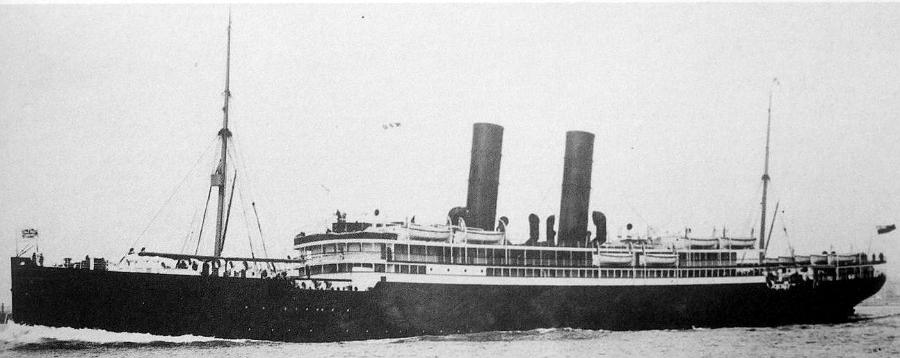
S.S. Caledonia prior to World War I, date and place unknown. Photograph courtesy of Old Ship Photo Galleries (http://www.photoship.co.uk).
Although the Australian Imperial Force strength in France varied in response to battle casualties and problems with recruiting, it never fell below 117 000 men. Its battle casualties for three years of trench warfare between 1916 and 1918 amounted to over 181 000 men of whom more than 46 000 died. Another 114 000 were wounded, 16 000 were gassed and almost 4000 taken prisoner. In terms of total deaths per 1000 men mobilised, the Australian Imperial Force figure was 145 – the highest of all the British Commonwealth armies.
Carl Gow was promoted to L/Corporal on November 11 1915, to R.Q.M.S.W.O. Class II on the 14th of April,1916 (Regimental Quartermaster Sergeant) - The RQMS is the senior assistant to the quartermaster of a regiment or battalion and also usually functions as the deputy regimental sergeant major. Some units have more than one. RQMS was a separate rank until 1915, when it became a warrant officer appointment with the creation of the rank of warrant officer class II.
Carl Gow was promoted again to 2nd Lieutenant on August 2nd, 1916 and Lieutenant on the 9th of February, 1917 and a Warrant Officer (Temp.) in May 1917.
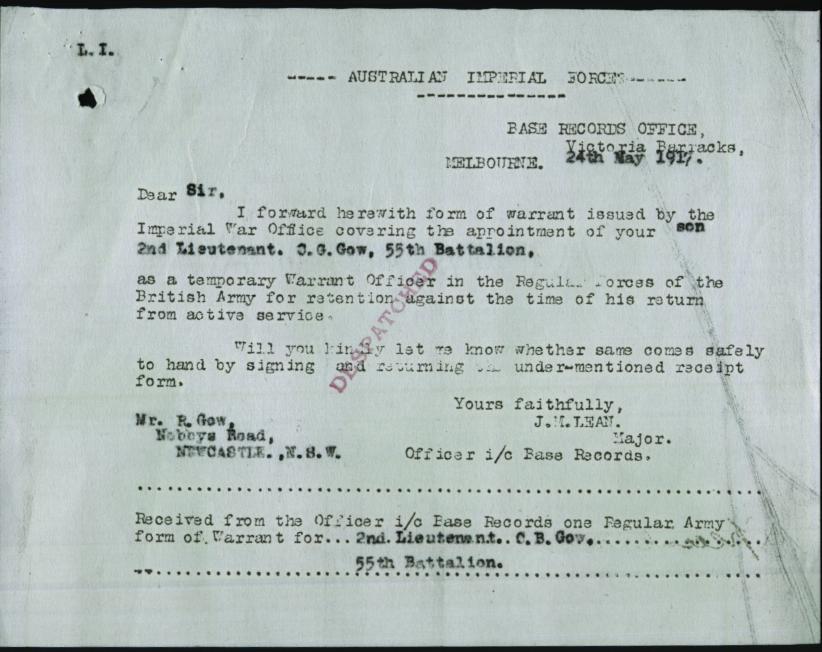
Made a Quartermaster and Honorary Captain on September 18 1917, he would have made trips to and from Rouen and back to the 55th - so now 'in the trenches' for him.
Group portrait of officers of the 55th Battalion.
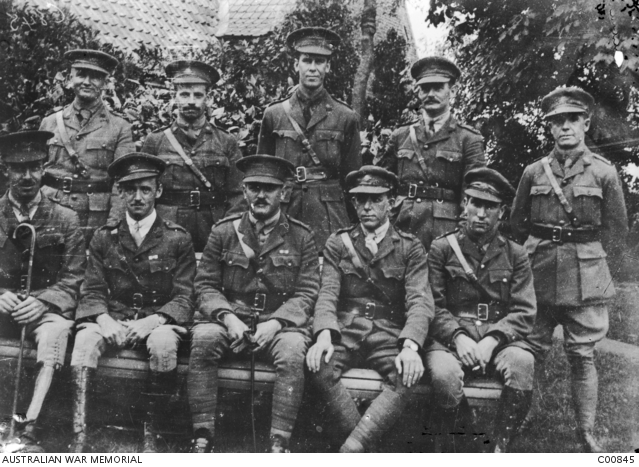
Identified from left to right, back row: Chaplain David de Venny Hunter, (killed in action 28 September 1917 and buried in Hooge Crater Cemetery (Plot II, Row F, Grave No. 16), Zillebeke, Belgium); 1287 Lieutenant (Lt) William Ernest Campbell; Lt James Edward Murray (later OBE), Divisional Intelligence Officer; 2827 Lt Reginald Howes Wilkin, Assistant Adjutant; 2689 Lt Reginald Arthur Smith, Assistant Quartermaster. Front row: Major (Maj) Hugh Alexander Wyllie MC, AAMC, Medical Officer; Maj Eric William Stutchbury, MC and Bar, 2IC; Lt Colonel Percy William Woods MC, Commanding Officer; 885 Captain (Capt) Norman Ewart Pinkstone, Adjutant; 2261 Capt Carl Beeston Gow, (later MC), Quartermaster. Maker: Unknown. Place made: France. Date made: c 1917-1918. courtesy AWM
During the First World War the British used Rouen as a supply base and there were many military hospitals. It is also the place well known for being where you may find Notre Dame cathedral and an astronomical clock dating back to the 16th century, though the movement is considerably older, is located in the Gros Horloge street.
In September 1917, the 55th Australian Infantry Battalion was heavily involved in the Battle of Polygon Wood, which took place in Belgium on September 26. After a major action at Polygon Wood, they consolidated their positions and extended them to prevent German counter-attacks, according to the Sir John Monash Centre. The 55th had previously participated in the advance following the German retreat to the Hindenburg Line in early 1917.
During the German Offensives, the Battalion valiantly defended to the north of Villers-Bretonneux and held these even after the German capture of the village.
The Australian War Memorial states that the 5th Australian Division suffered 4,014 killed and wounded during the Battle of Polygon Wood. The 4th Australian Division, which also participated in the battle and lost about 1,700 soldiers.
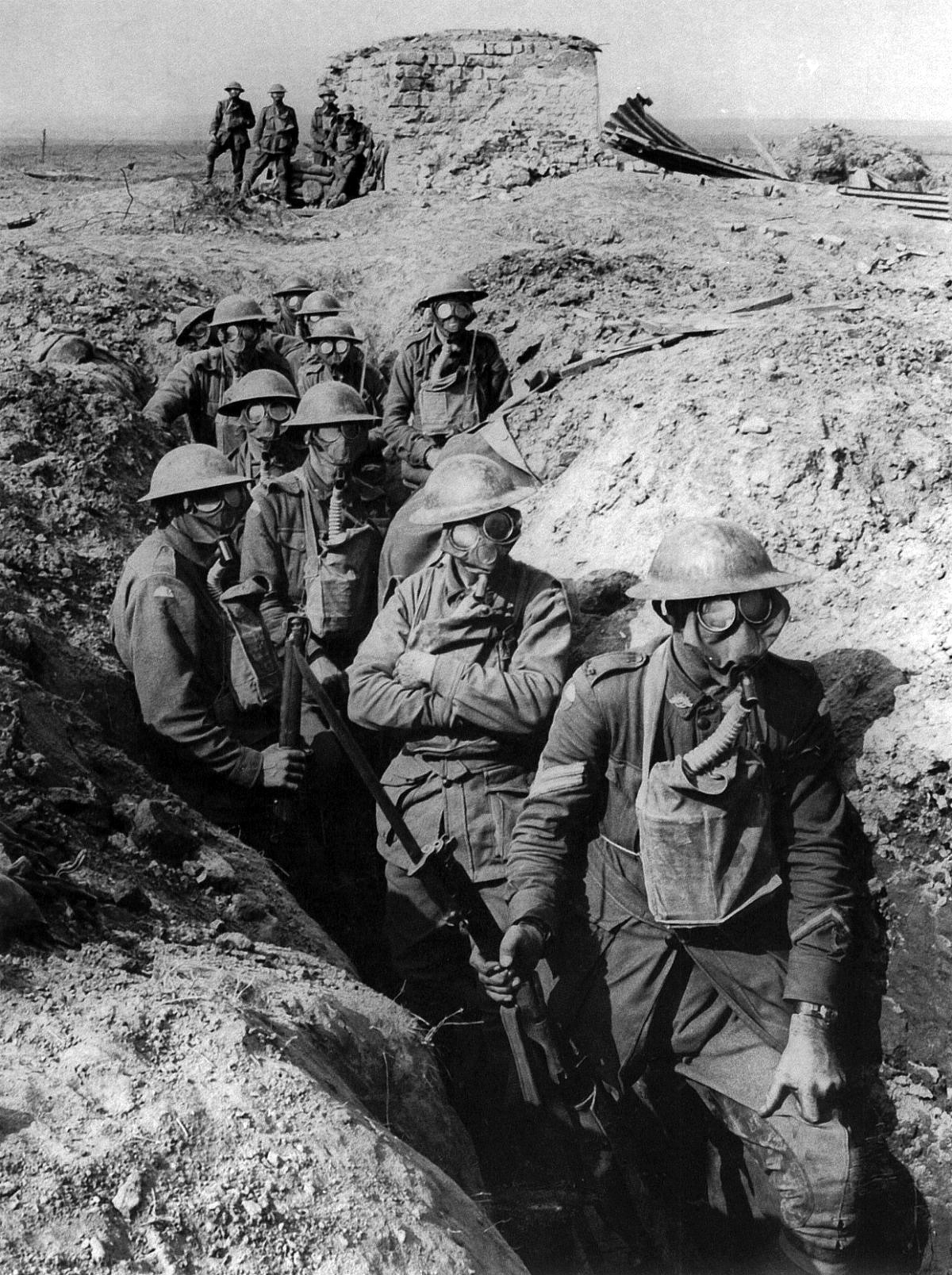
Australian infantry wearing Small Box Respirators (SBR). The soldiers are from the 45th Battalion, Australian 4th Division at Garter Point near Zonnebeke, Ypres sector, 27 September 1917. Photo by Captain Frank Hurley.
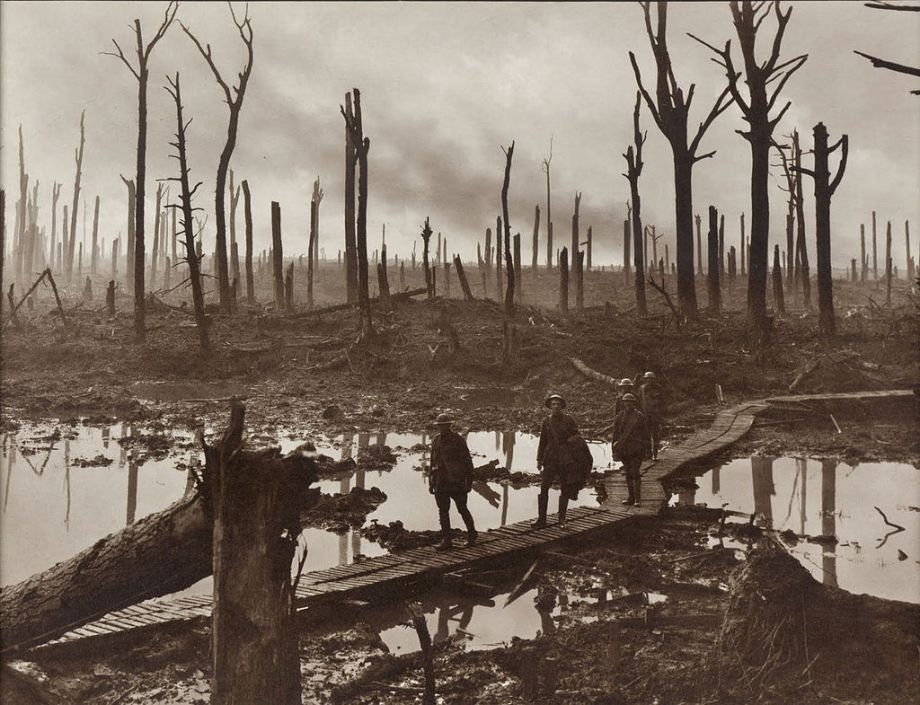
Soldiers of an Australian 4th Division field artillery brigade on a duckboard track passing through Chateau Wood, near Hooge in the Ypres salient, 29 October 1917. The leading soldier is Gunner James Fulton and the second soldier is Lieutenant Anthony Devine. The men belong to a battery of the 10th Field Artillery Brigade. Australian War Memorial E01220. Frank Hurley Photograph.
Carl Gow was mentioned in dispatches 25th December 1917; London Gazette; Sir Douglas Haig’s Despatch and had been recommended for a Military Cross on September 20 1917 - meaning that 2 days after he was once again promoted to Quartermasters and Hon. Captain something happened which showed the 'metal of this man'.
He was finally Awarded this Military Cross on the 4th of June 1918. The Military Cross is granted in recognition of "an act or acts of exemplary gallantry during active operations against the enemy on land to all members, of any rank in Our Armed Forces…"
Carl Gow’s records record these words and also the dates ‘from 26.2.1917 to 25.9.1917’, indicating he was a persistent helper of those beside him during these 1917 months.
This may be why those who met him at Palm Beach had such a profound and lasting respect for the man as these qualities persisted throughout his life - a few insights from those who knew him share:
You still quite young when you met Carl?
Peter Verrills: he was a wonderful man. A man full of knowledge.
Did you know he was a Captain at the end of WWI?
Peter V: yes, in the Army, First world war. He got blasted to buggery – they sent him to France and then he walked away.
John Arblaster: he found this solider with his leg blown off, and he threw his greatcoat over him, to keep him warm until the Medics got to him. Later on in life when he was here at the boatshed, there was a fella that bought a house up on the hill there. His name was Harold Richardson and this turned out to be the solider who he had saved.
Peter V: Harold Richardson, unbeknownst to Carl, was his batman. They were good mates until he died and Harold became the secretary of the Palm Beach RSL when that first opened. I remember Harold as a kid; he used to get around in a Ford with a big gas burner on the back of it because there wasn’t enough petrol then.
Tom Gilbert: He was a wonderful man, a true gentleman. He really cared about people and doing for ourselves, looking after each other and the community.
MILITARY HONOURS. The "London Gazette" contains the following list of members of the Australian and New Zealand Expeditionary Forces who have been decorated: BARS TO MILITARY CROSSES. Australians.-Captain F. E. Fairweather, Lieutenant J. H. Julln. MILITARY CROSSES. Australians.- Quarter masters ... C. B. Gow, MILITARY HONOURS. (1918, June 6). The Sydney Morning Herald (NSW : 1842 - 1954), p. 7. Retrieved from http://nla.gov.au/nla.news-article15786666
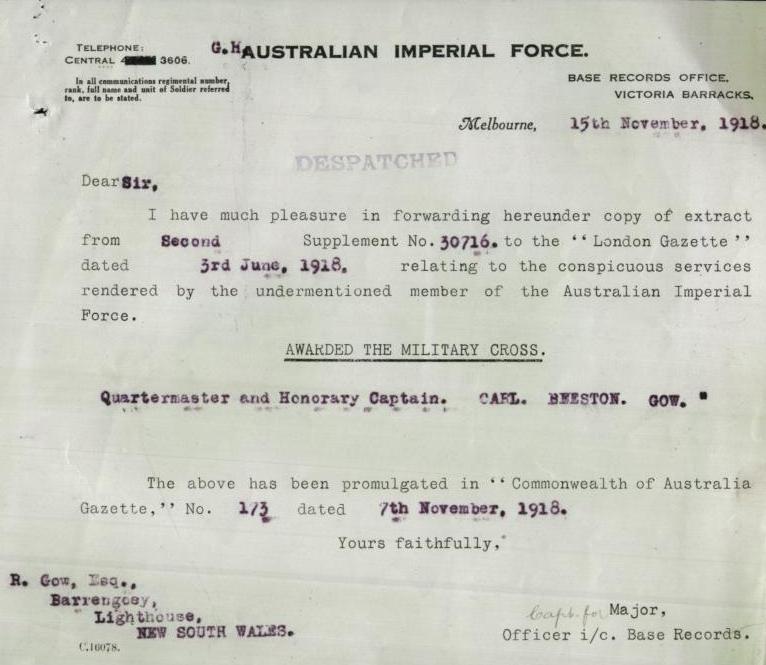
Later that year he was granted Leave and went to Paris – 27th of September 1918. On the 13th of December 1918 Carl was made an Honorary Captain, signalling those promoted during the horrific battles were ineligible to retain that rank thereafter under what occurred then in our society and defence force protocols.
On March 1st 1919 he was sent on Leave to the U.K. for Investiture, reporting to the Headquarters in London on the 4th of March.
In 1920 he also received the 1914–15 Star, a campaign medal of the British Empire, for service in World War I, the British war Medal and the Victory Medal.
Meanwhile his father, Robert sent a letter from Barrenjoey Lighthouse dated 13.3.1919 requesting information about Carl; is he still in France or on his way home??? No one knew where he was, including the AIF - although he would have been steaming home when this correspondence took place:
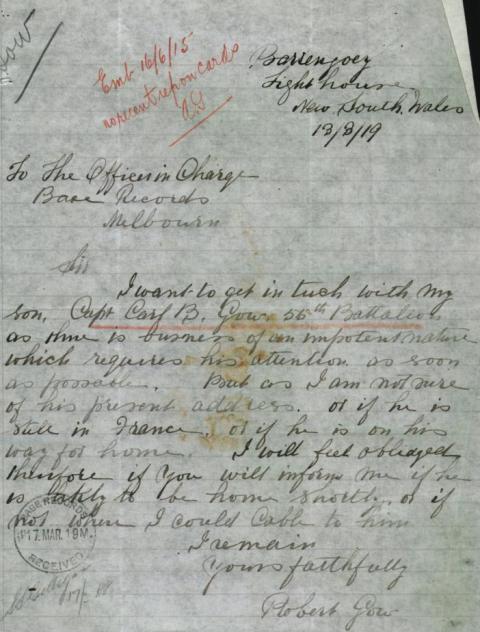

Carl Gow returned to Australia per the ‘Traz os montes’ or ‘Eros Montes’ as spelled in some files.
He disembarked on the 22nd of May 1919 and made his way here to be reunited with his family then lightkeepers at Barrenjoey where he also then worked as a relieving lightkeeper for a while. It was a few days over four years when he finally came home and days before he resumed or took up a new way of life.
Carl settled into civilian life in Palm Beach, establishing the Gow-Gonsalves Boatshed, working as a fisherman, and opening a general store which was where everyone in Palm Beach voted during any election. Clearly the time spent as a Quartermaster and his years in admin prior to enlistment were skills that came in handy, along with mates met during the battle with storekeeper knowledge:
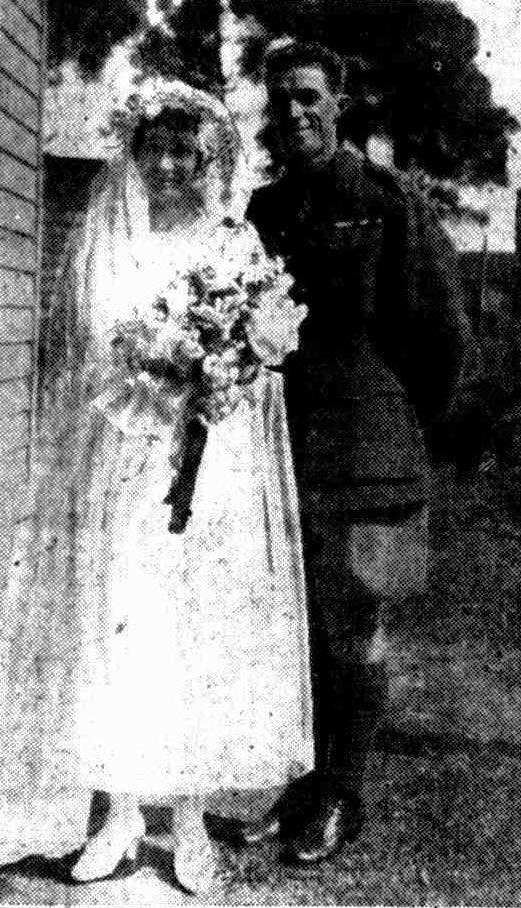
It's worth noting that Reg. Howlett is dressed in his or Carl's Army clothes in this official wedding photo almost a year after the boys came home (AIF privates were generally not issued jodhpurs during World War I.). Many of those who enlisted did not have the means to purchase expensive clothes and boots, so to honour their mates, as much from a fiscal perspective, those provided by the AIF were in many cases 'their best' duds and had been made from the best Australian woven wool (winter campaigns) and cotton (summer), and made to last for the duration - and consequently lasted long afterwards as well. Even well into the 1980's you could pick up an ex-WWII wool greatcoat from Vinnies or Red Cross shops for a song - and these were warmer and better cut to fit than todays 'fashions'.
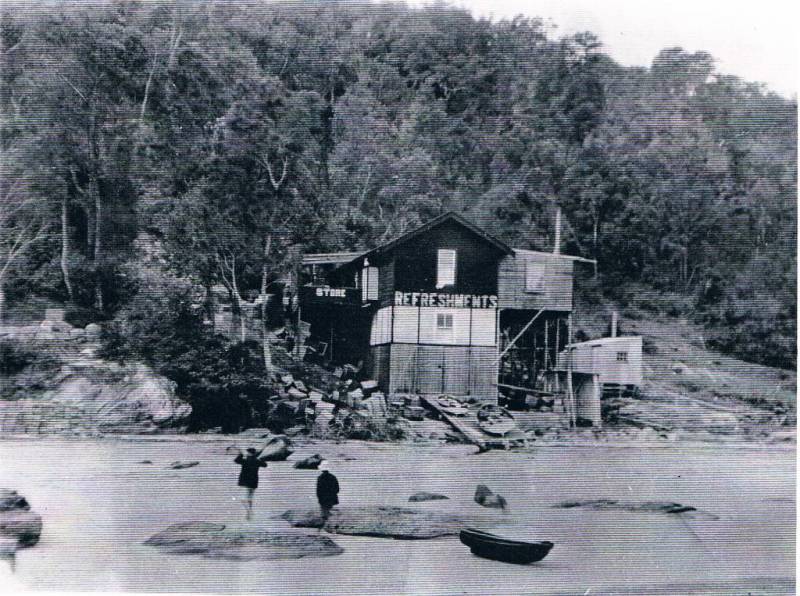
Above and Below: Gow's Store in its early days courtesy Peter Verrills
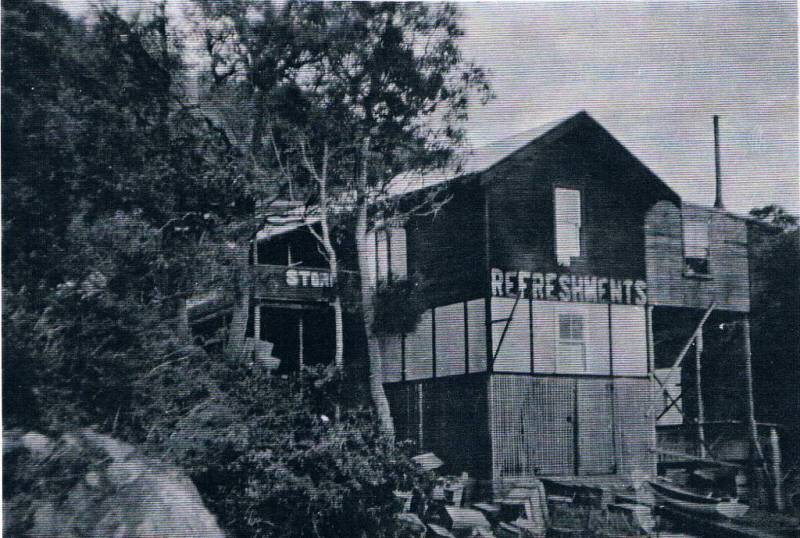
PALM BEACH.-Furnished Cottages to Let and For Sale.- Gow and Howlett, Store. Phone. 24. Advertising. (1921, April 23). The Sydney Morning Herald (NSW : 1842 - 1954), p. 4. Retrieved from http://nla.gov.au/nla.news-article28086899
The first general store was at Palm Beach, on the Pittwater side near the jetty, as early as 1914, and was known as Booth's store. Later it became Ellis' store, and then after the last war two returned Diggers, Mr. Fred Howlett and his partner, Gowe, took it over. Their general supplies came by ship from Sydney by the Erringhi and the Kallawatta, and meat and bread came by launch from Newport. They made their own ice-cream in those days, and froze it in old fashioned freezers with coarse salt. It was just as popular as the well known brands are today.
It was not until 1929 that Howlett's store was established on the beachside of Palm Beach. Before that there was no road through from Pittwater, and the top road was used by residents. Palm Beach setting for smartest sea and sun togs. (1946, January 12). The Australian Women's Weekly (1933 - 1982), p. 22. Retrieved from http://nla.gov.au/nla.news-article47245736
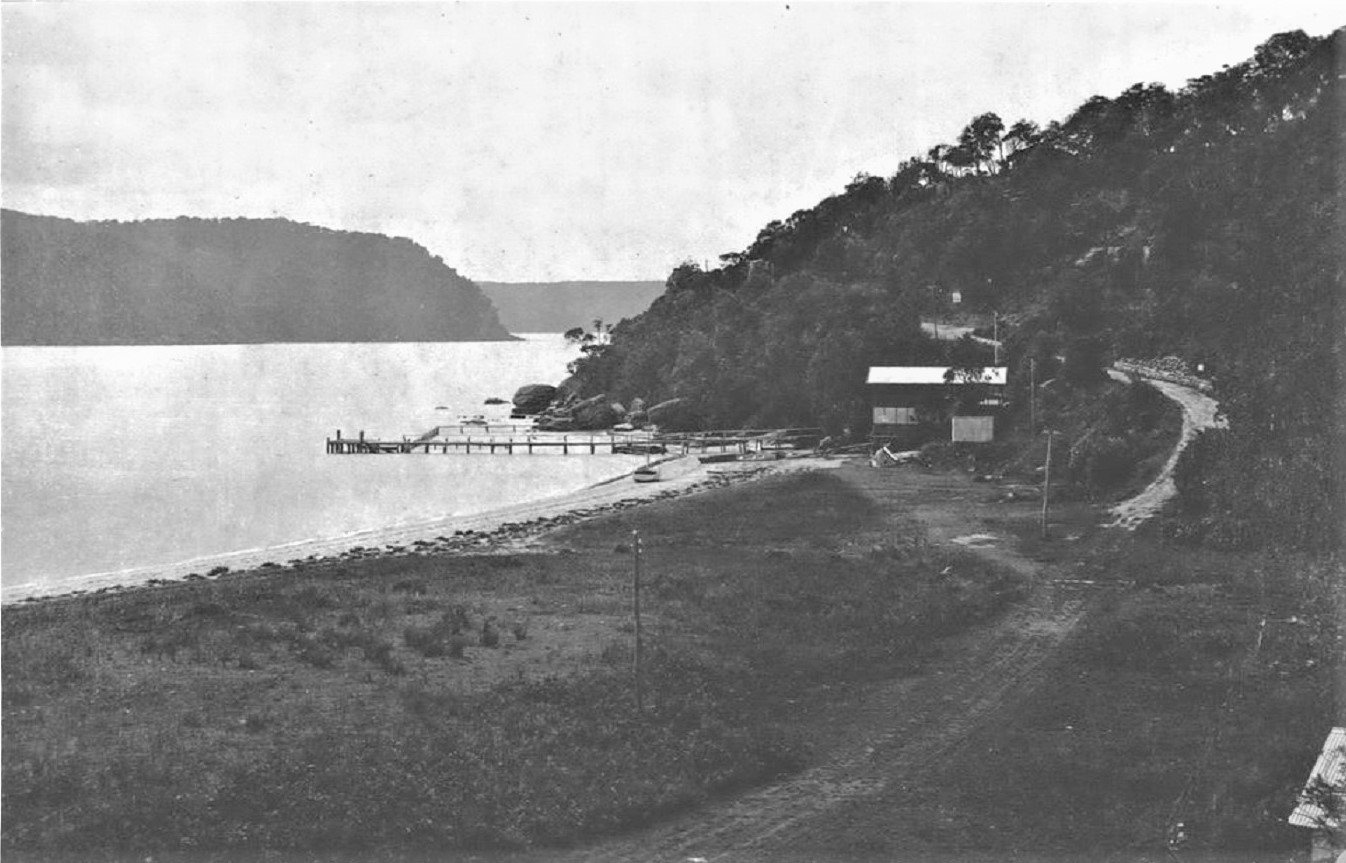
Barrenjoey Road, Pittwater Park prior to being resumed and named as such and Ferry Wharf - Gows Jetty with Pool area shown circa 1917-1920. Gow-Gonsalves-Verrills family photo
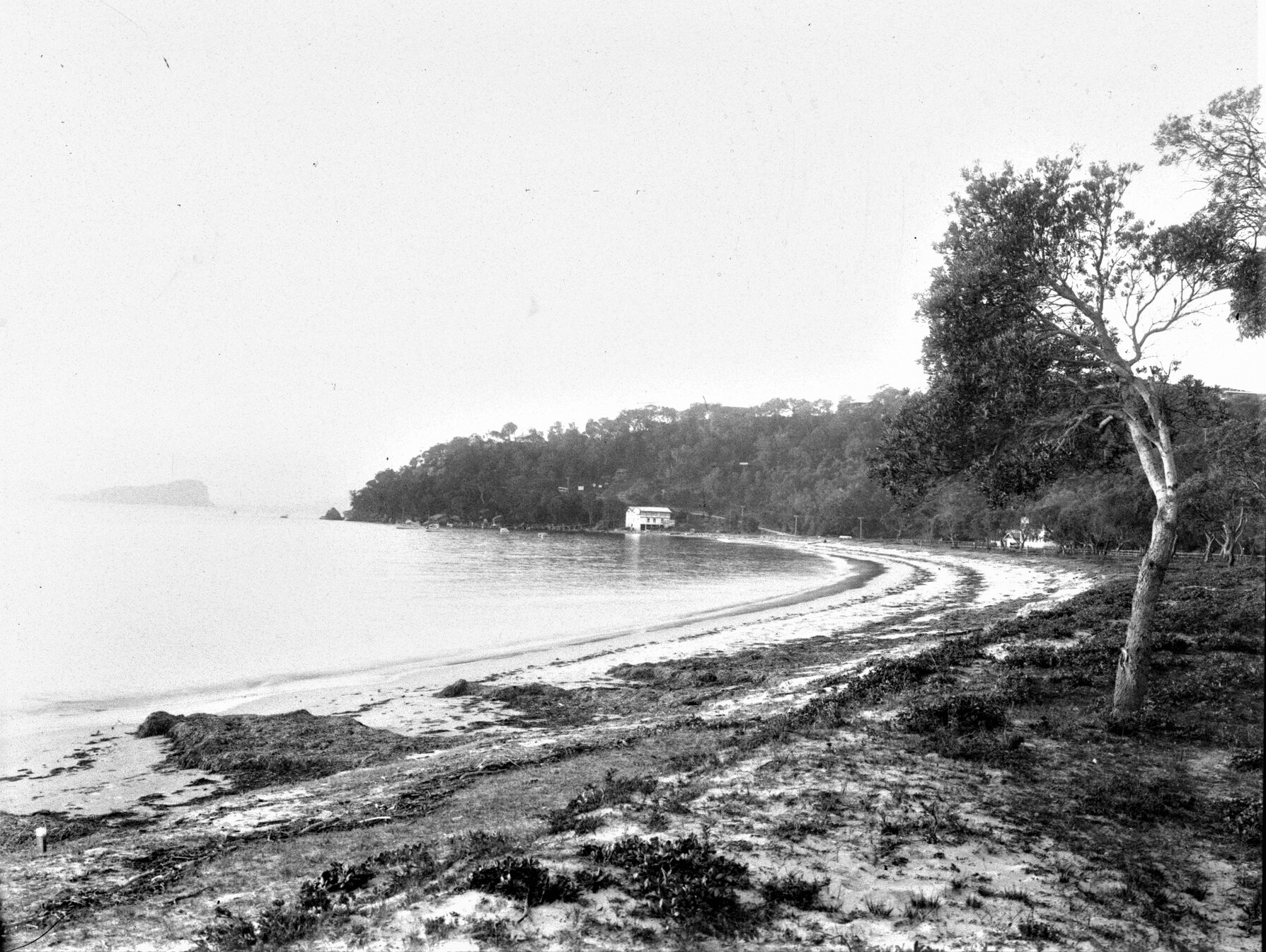
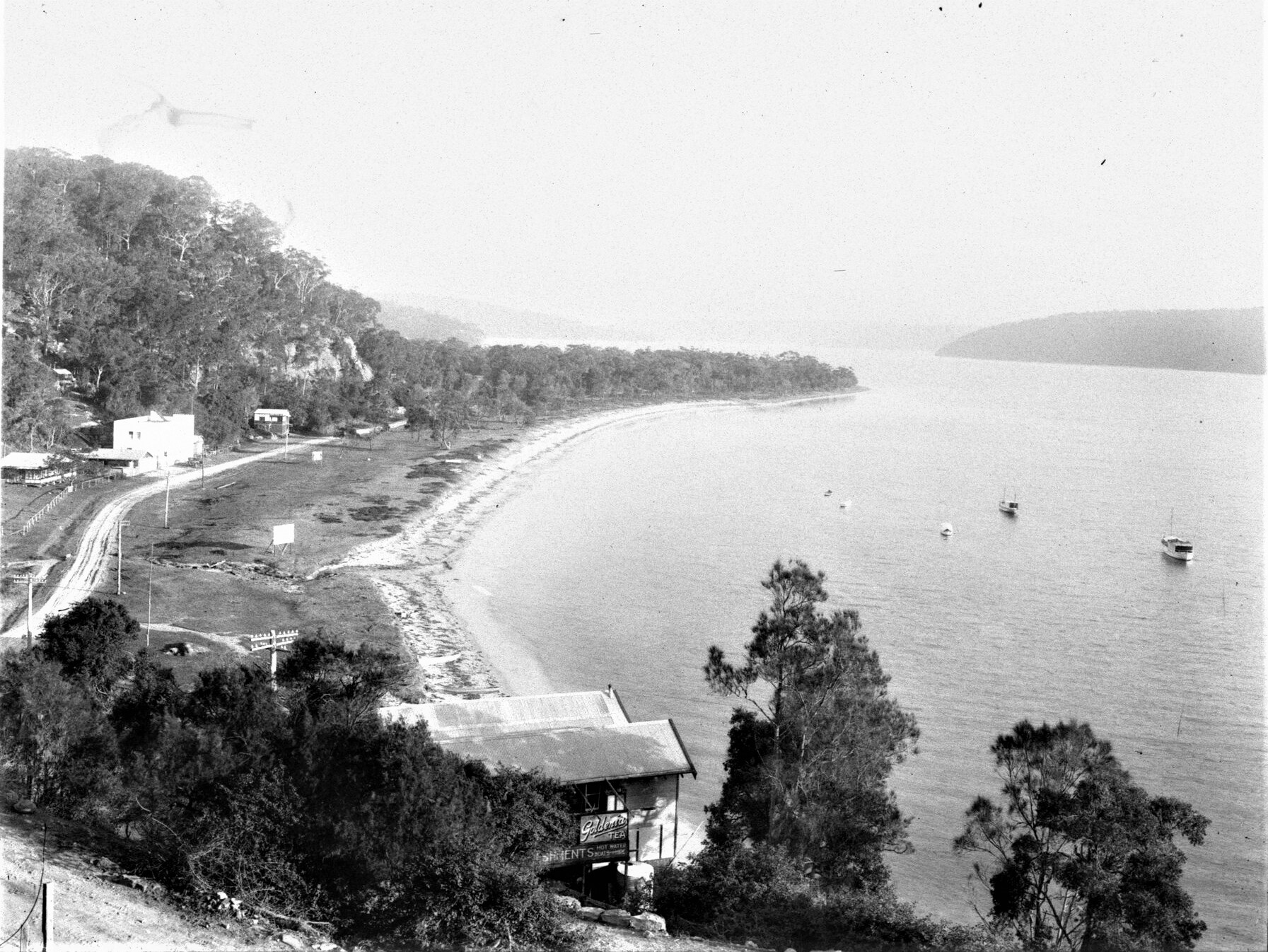
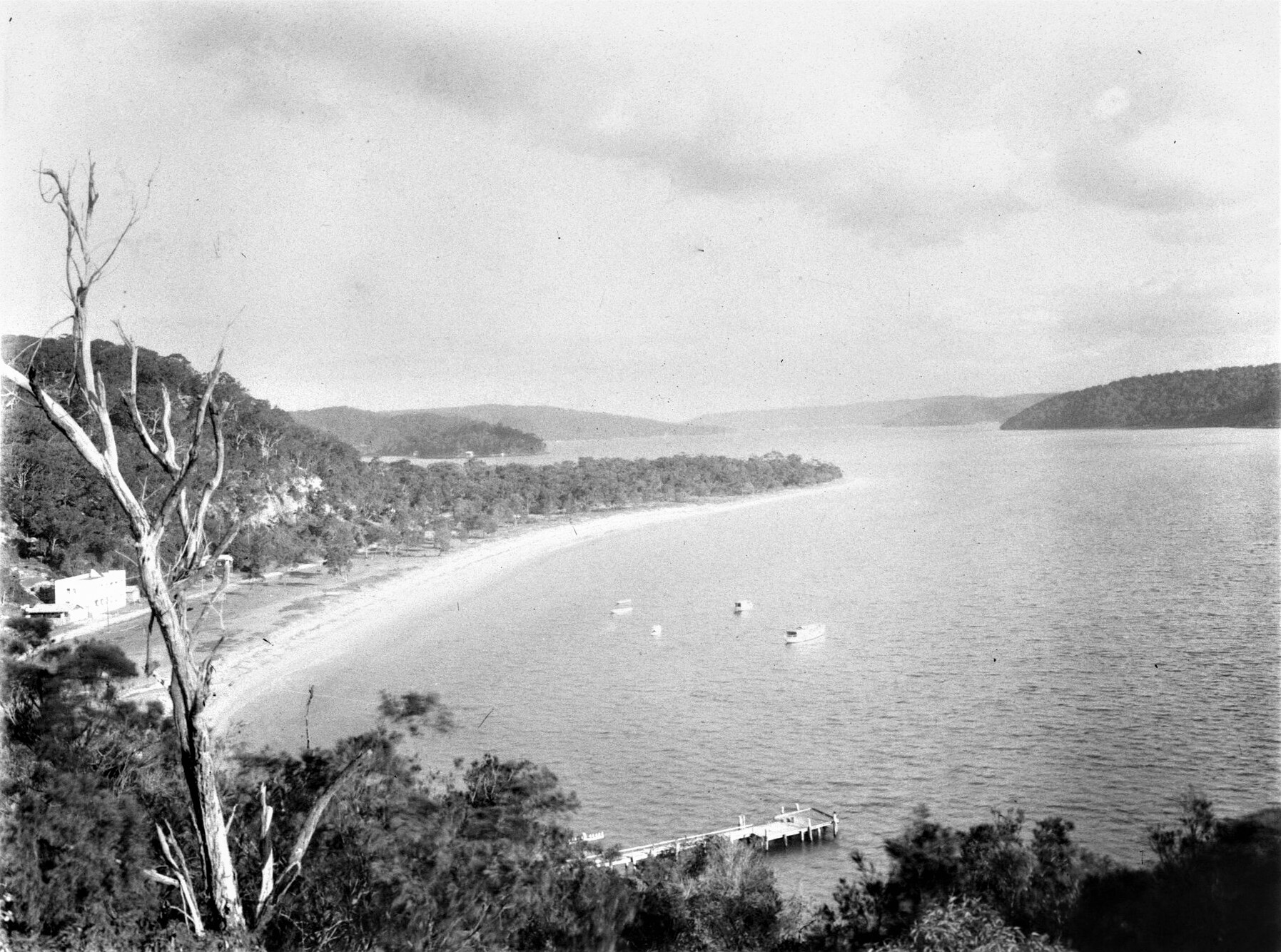
The Gow/Gonsalves lands here - from Historical Land Resources Viewer:
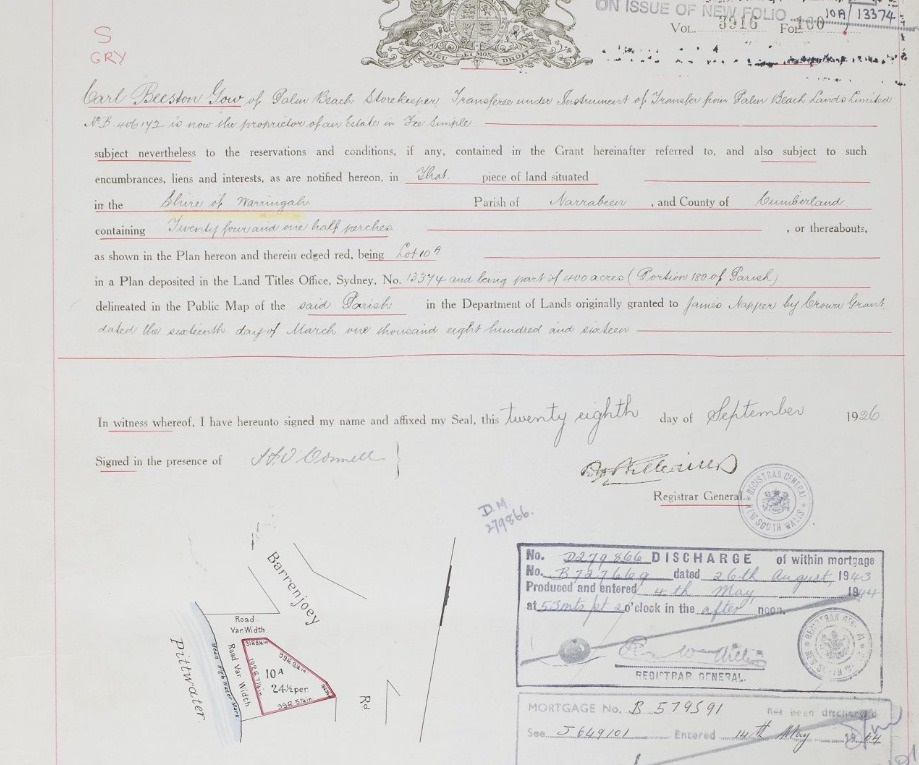
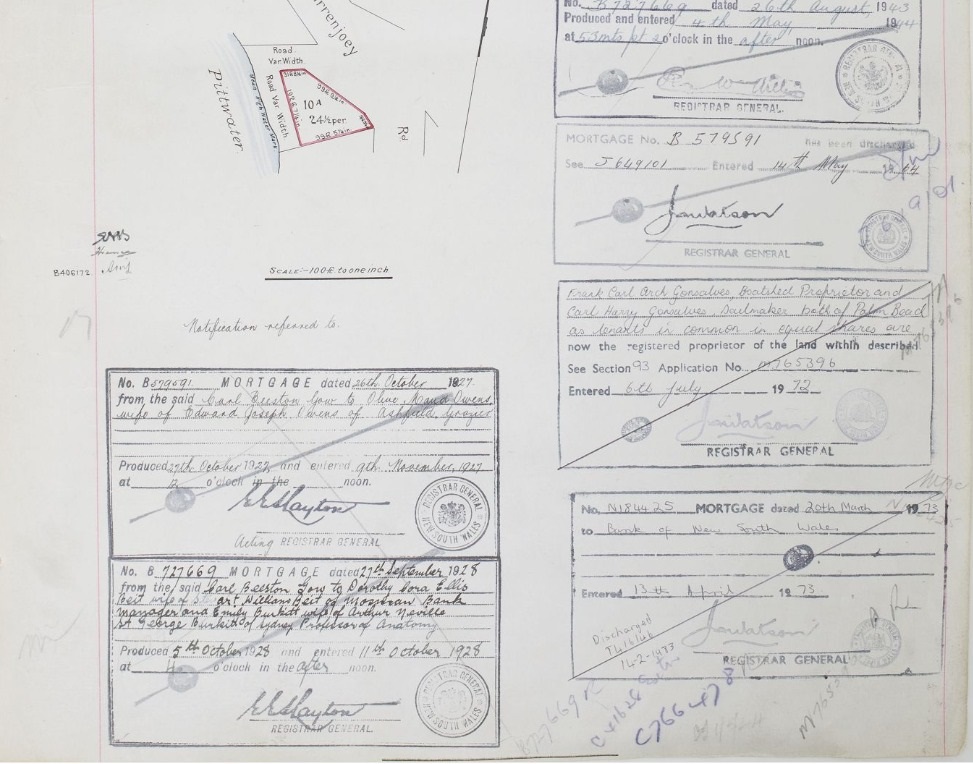
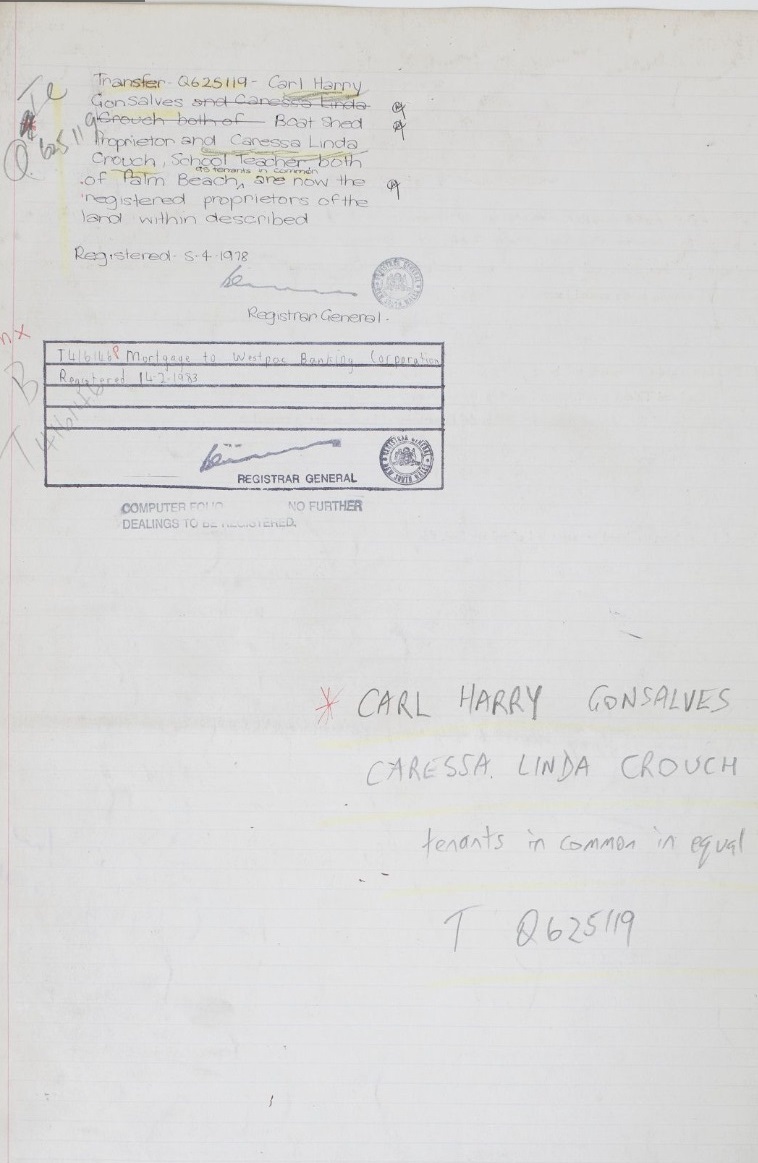
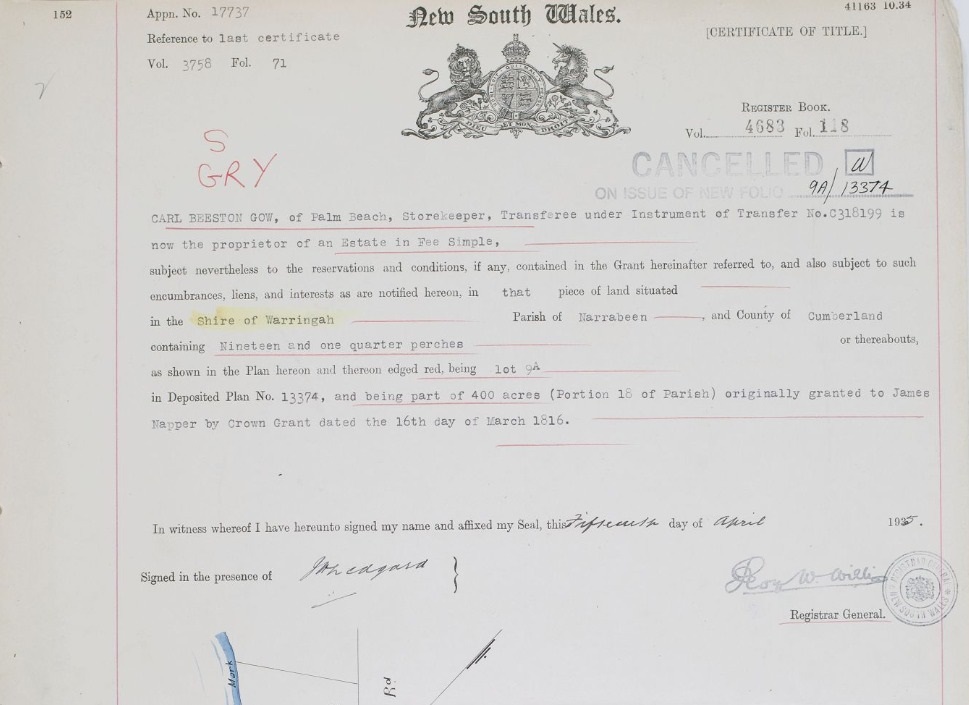
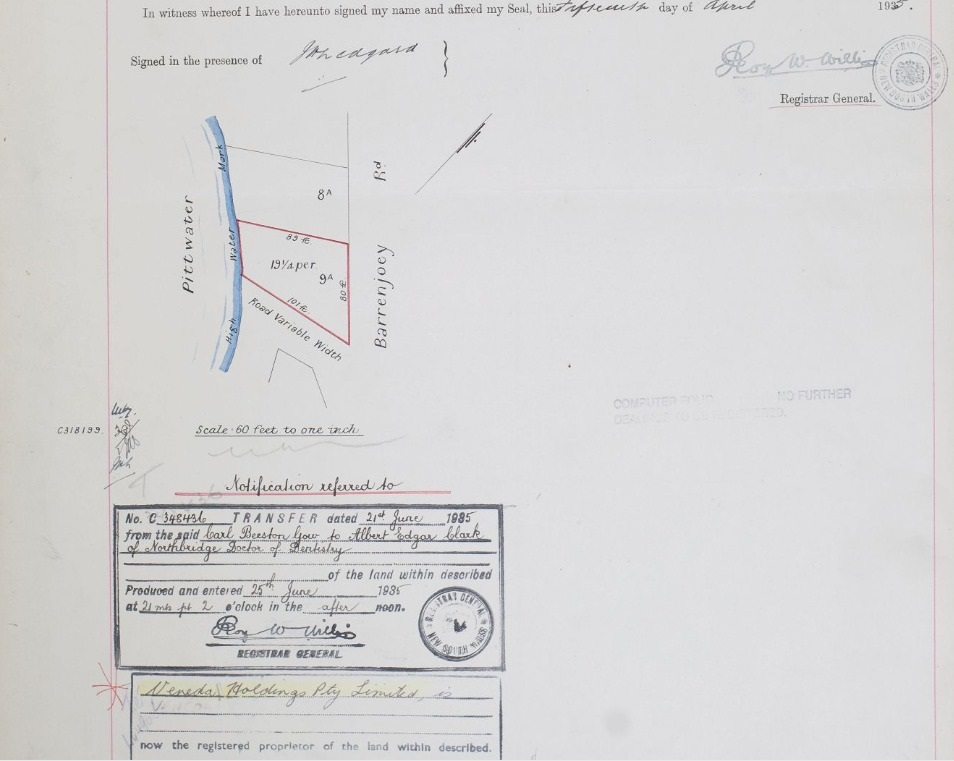
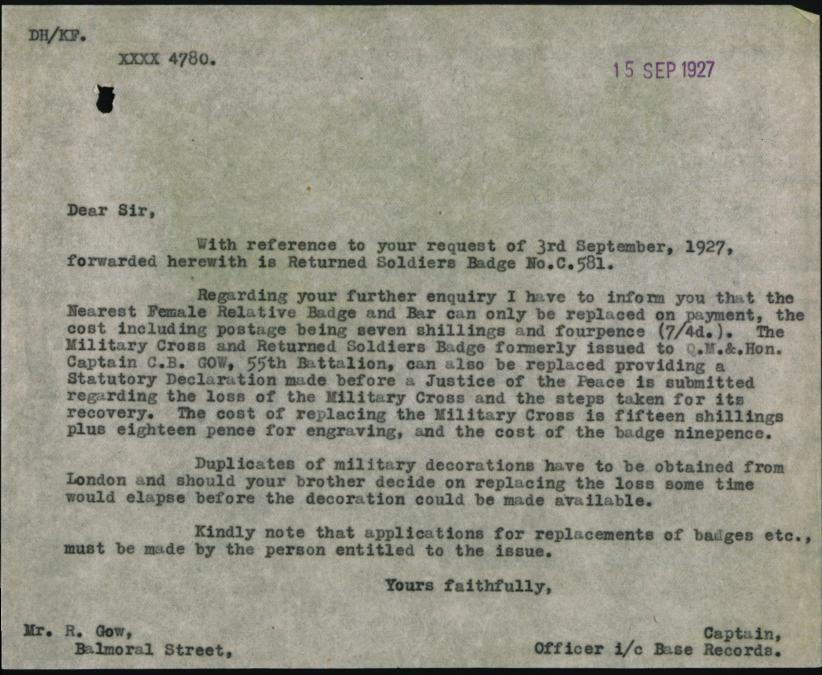
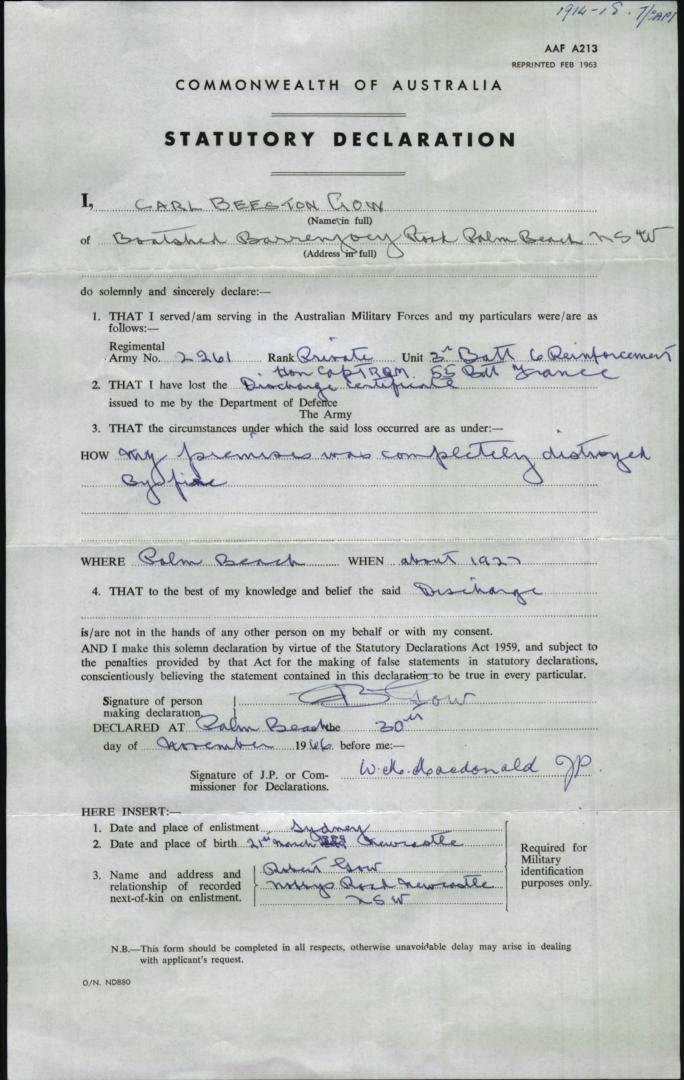
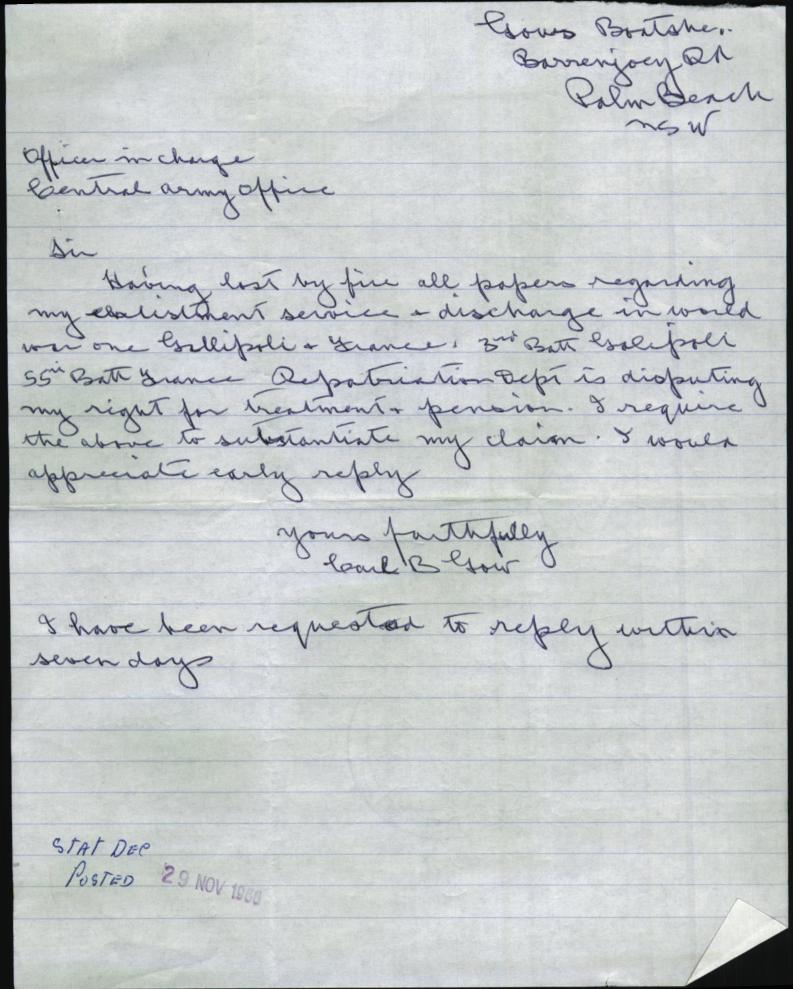
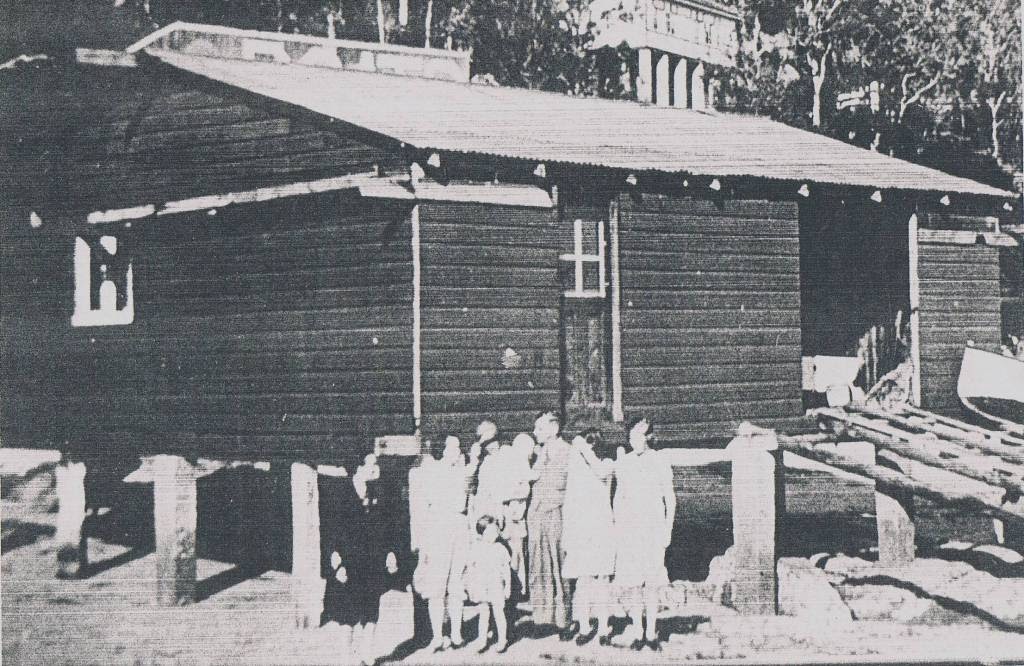
Gow's-Gonsalve's Boatshed circa 1935-1940 - Photo: Verrills Family photos
.jpg?timestamp=1645561750254)
Gows and Gonsalves boatshed taken from Carls originals courtesy Peter Verrills, circa 1939-1940
Local lore states what we now call Pittwater Park, beside the current ferry wharf for Palm Beach, stems from a bet between Carl Gow and Cr. George William Hitchcock of Warringah Council (for whom Hitchcock Park at Careel Bay is named and who was a Palm Beach resident himself); the bet being the Councillor could not get it gazetted as a park which he did, Carl having to hand over £100 for losing. Those who knew Carl state the bet was a ruse as this land was obviously slated for sale and development prior to then.
In the official Warringah Shire Council Records the Minutes of a Meeting held in 1924 records it was the then named 'Palm Beach Residents Association' put forward an appeal to reserve the land for public use and foreshore access, and later, in 1935 as the reformed 'Palm Beach Progress Association' (formalised in 1933 with W J Goddard as first official Secretary), put forward the proposed name to the WSC, which was duly agreed to. This residents association, and its current iteration as the Palm Beach-Whale Beach Association, alike the Palm Beach SLSC, comprised and relied upon a large permanent residents contingent as much as the backing of those who had 'weekenders' and influence in state and federal government circles.
This Park was Gazetted 21/1/1927, finalised 23.9.1927. The Government Gazette Notices provide:
NOTIFICATION OF RESUMPTION OF LAND UNDER THE PUBLIC WORKS ACT, 1912.
IT is hereby notified and declared by His Excellency the Governor, acting with the advice of the Executive Council, that so much of the land hereunder described as is Crown Land has been appropriated, and so much thereof as is private property has been resumed under the Public Works Act, 1912, for the following public purpose, namely, for the establishment of a Public Recreation Ground at Palm Beach, and is vested in the Minister for Lands as Constructing Authority on behalf of His Majesty. [Misc. 1926-13,363]
Signed and sealed at Sydney, this twenty-first day of January, 1927.
( i,s.) D. R. S.de CHAIR, Governor.
By His Excellency's Command,
W. F. DUNN, Assistant Minister for Lands.
GOD SAVE the KING!
Description.
All that piece or parcel of land situate in the parish of Narrabeen, county of Cumberland, and State of New South Wales, containing an area of 1 acre 1 rood 17 1/2 perches: Commencing at the high-water mark of Pittwater at the north-western corner of lot 11 of section A of the Forssberg Estate,—as shown on d.p. 12,979; and bounded thence on the south by the northern boundary of that lot bearing 90 degrees 57 minutes for 152 feet to the western side of Barranjoey-road; thence on the east by that side of that road bearing 8 degrees 53 minutes 30 seconds for 278 feet 6| inches and 350 degrees 49 minutes for 126 feet inches; thence on the north by a line bearing 270 degree's 57 minutes for 143 feet to high-water mark, Pittwater, aforesaid; thence on the west by that high-water mark generally southerly, to the point of commencement, and being lots 1 to 10 inclusive, of the Forssberg Estate,—as shown on d.p. 12,979, and being also part of freehold portion 18 of 400 acres. NOTIFICATION OF RESUMPTION OF LAND UNDER THE PUBLIC WORKS ACT, 1912. (1927, January 21). Government Gazette of the State of New South Wales (Sydney, NSW : 1901 - 2001), p. 418. Retrieved from http://nla.gov.au/nla.news-article220227921
Pittwater Park confirmed:
PROCLAMATION
For Public Recreation.
Metropolitan Land District, and Warringah Shire.
No. 60,988. County of Cumberland, parish of Narrabeen, containing an area of about 2 acres 1 rood 12 1/2 perches. The Crown Lands within the following boundaries: Commencing at a point on the high-water mark of Pittwater at the north-western corner of lot 11, section A, deposited plan 12,979; and bounded thence by the northern boundary of that lot Rearing 90 degrees 57 minutes 152 feet; thence by the western side of Barrenjoey-road, being lines bearing 8 degrees 53 minutes 30 seconds 278 feet 6 /4 inches and 350 degrees 49 minutes 486 feet 5 3/4 inches; thence by the south-eastern boundary of lot 10A of deposited plan 13,374, and end of road of variable width, being a line bearing 243 degrees 20 minutes 132 feet to the high-water mark of Pittwater; thence by that high-water mark of Pittwater- generally southerly, to the point of commencement, comprising lots 1 to 10 inclusive, deposited plan 12,979, and the unsubdivided balance of lot 32 of the Bassett Darley Estate. [Us. 1927-9,366] RESERVES FROM SALE. (1929, February 22). Government Gazette of the State of New South Wales (Sydney, NSW : 1901 - 2001), p. 1016. Retrieved from http://nla.gov.au/nla.news-article223989484
Warringah Shire Council - minutes from meetings:
March 13, 1933 Meeting:
(46) Palm Beach Progress Assoc.; 25/2/33. advising Council of formation of Association, with Mr. C.P. Curlewis as President, and Mr. W. Goddard, Sen. as Acting Secretary.
Two years later:
2. Palm Beach Progress .Assoc., 14/3/35, pointing out that the absence of a notice bearing the name "Palm Beach" on the public wharf is the cause of uncertainty and inconvenience to visitors by launch; (b) on the necessity for a name for the reserve opposite Barrenjoey House, suggesting the name “Pittwater Reserve”; (c) pointing out the need for repairing and widening Palm Beach Road to render it less dangerous; (d) expressing the opinion that the building of a concrete retaining wall on the ocean beach reserve would detract from the appearance of the beach. Council's decisions.:- (a) That a notice be erected as requested; (b) that the name Pittwater Reserve be adopted., (Crs. Hewitt, Austin);
Carl also opened the Rendezvous Tea Rooms with one of the Gonsalves family members (now the Boathouse Groups' PB home) in the mid-1920s and this became a social hub of Palm Beach.
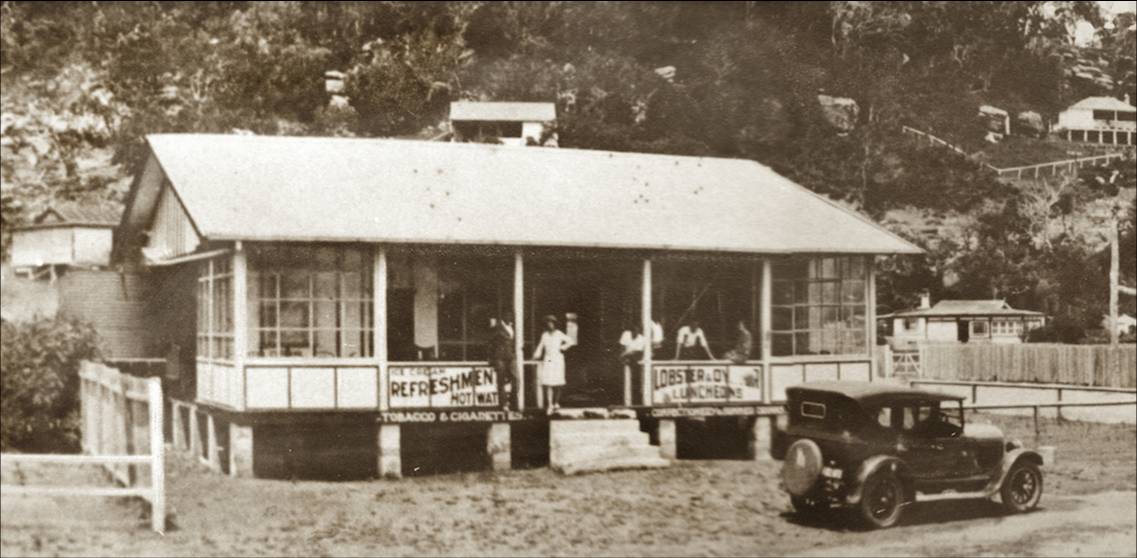
FIRST BALL - PALM BEACH GOLFERS
OVER 150 guests attended the first annual ball of the Palm Beach Golf Club, held at The Rendezvous. Palm Beach . Card tables were provided for non-dancers. Among those present were the president, Mr. S. H. Hammond, and Mrs. Hammond, vice-president. Messrs. B. B. Wiltshire, C. R. Crossman, E. R. Moser, D. B. Wiltshire. J. E. Armstrong, Percy Hunter, B. L. Houghton, Lady Maitland, Miss Cook. Mesdames S. J. Robinson, Peters, Brown, K. Barr. A. H. Aplelt, W. Woodley, Harper, C. A. Broughton, B. B. Wiltshire. H. Hendry. Wolstenholme, Hooper, Jeremy, P. H. Rush, E.B. Clarke, Misses M. and F. Coyle, Mackay, Brown. Molly Hawkes, Kathleen Strange, Biddy Bellbridge, Enid Donovan. H. Trewthze, Oarran, Wolstenholme, H. Dickson, V. Hendry. Walker, Goddard, Phyllis Clarke, M'Kenzie. L. Myers, Carlton, H. Hillyar, S. Myers, B. Downey, M. Campling, S. Downey. L. Campling and Messrs. J. Coyle, Peters, E. Barr, S.J. Robinson, Gibbons, S. Cutner, Lance Mullins, P. L. Houghton, J. Coyle, A. S.Mann, A. H. Aplett, W. W. Woodley. C.A. Houghton, H. D. Wolstenholme, E. Holden, C. Pulley. B. P. Dawson, Hooper, Jeremy. L. Jones, A. Britton. C. A. Clarke, Coffey and Hunter. FIRST BALL. (1929, April 8). Evening News (Sydney, NSW : 1869 - 1931), p. 10. Retrieved from http://nla.gov.au/nla.news-article118778203
The Palm Beach Surf Live-Saving Club will hold its annual dance at the Rendezvous Tearooms, Palm Beach, on December 28.The proceeds will go to the club's funds. Among the attractions at the dance will be a competition, the prize for which will be a flight in a seaplane, given by Captain J. Pentland. NEAR AND FAR. (1929, December 17). The Sydney Morning Herald (NSW : 1842 - 1954), p. 4. Retrieved from http://nla.gov.au/nla.news-article16610763
AT PALM BEACH
"EVENING dress was distinctly "not done" at the New Year's Eve dance at "The Rendezvous," Palm Beach, last night. Among the 170 who came for the fun only one girl wore an evening gown, the rest donned beach or sports costumes, with bizarre effect. Some girls chose "flannels" — the long, cream trousers that men wear' on the tennis court; Mrs. Pat. Levy chose shorts, with a large Mexican hat and silk shirt; Miss Margery Rutherford's scarlet shorts were a gay splash of color with her sleeveless silk shirt. Mr. Ronnie Nott added a touch of Highland gaiety with tartan shorts. Shorts, sandshoes, plus-fours, sweaters, or any sporting wear was the mode — the lack or conventionality making it one of the happy memories the holiday-makers present will take away with them. The hearty singing of "Auld Lang Syne at 12 o'clock ushered in the New Year. AT PALM BEACH (1930, January 1). The Sun (Sydney, NSW : 1910 - 1954), p. 2 (LAST RACE RESULTS). Retrieved from http://nla.gov.au/nla.news-article226020644
Along with the Goddard men, the Gonsalves, Verrills and Carl were those called on to rescue those in trouble at sea after the Broken Bay Customs Station was closed. Their fishing vessels not only provided a mans to get to those sinking, once again generations of saltwater in their blood and knowledge of the local seas and conditions helped.
YACHT IN TROUBLÉ. Dismasted at Sea. SURF BOAT TO THE RESCUE.
A few minutes before 2 o'clock on Saturday afternoon the eight-metre yacht Brand V., owned and sailed by Mr. J. R. Palmer, was dismasted off Barrenjoey Beach. She was engaged In the Royal Prince Alfred Yacht Club's annual race for the Basin Cup, in which at the time of her mishap she had a good chance of success. Standing along the coast fairly well in-shore, close-hauled on the starboard tack in afresh north-easter, her topmast forestay or some other part of her for'ard gear carried away, and In an instant her mast snapped off short, just above the lower crosstrees. The upper part of her mainsail and mast, her jib, and most of her rigging, fell In a tangled mess to leeward, fortunately without injuring anyone, and she was left drifting helplessly on a lee shore.
Her ground tackle was not sufficiently good to enable her to anchor until assistance came, and her crew of five set a small Jib, Jury rigged on the 25ft stump of the mast, with a view to making for Barrenjoey and shelter. She was, however, unable to go about under this rig, and making considerable leeway she was In danger of going ashore.
The members of the Palm Beach Surf Club observed her plight, and about half an hour after the accident the surf boat, manned by Messrs. H. Hattersley, Gonsalves, P. Tress, H. P. Tattersall, and A. Wolstenholme, put to sea, and taking her in tow, endeavoured to lift her up to windward, assisting her ingoing about. Later she towed her towards the steamer Gosford when she came to assist. Meanwhile the lighthouse-keeper at Barrenjoey had communicated with Goddard's boat-shed at Palm Beach, and a launch was despatched. Her position was also observed by some of the other competitors, and Morna, returning to Sydney, made out of her course for the club steamer Gosford, which at the time was some two or three miles to the south-east. Hoisting an ensign upside down and the signal NC (want Immediate assistance), she conveyed the information that Brand was in sore straits. The Gosford immediately proceeded to the scene, and relieving the surf boat of its unwieldly burden, took the disabled yacht in tow about 80 minutes after the accident, finally dropping her at her moorings In Careening Cove (Careel Bay). The launch from Palm Beach stood by until Brand was safely in tow. Included In Brand's crew was a 15-year-old-lad, Jack Morris, who took a prominent part in hauling the heavy tow-line aboard and making it fast. YACHT IN TROUBLE. (1931, January 19). The Sydney Morning Herald (NSW : 1842 - 1954), p. 11. Retrieved from http://nla.gov.au/nla.news-article16746747
Men's Struggle To Save Yachts.
SYDNEY, Saturday.—
In mountainous seas which raged off Palm Beach yesterday and last night gallant work was performed by W J and A Goddard and S. Gonsalves in rescuing two fine yachts which had broken adrift from their moorings. It was not until after midnight that they completed their job. According to eye witnesses it was often touch and go whether they would meet with disaster themselves. In addition to the two yachts a launch broke its moorings and eventually piled up on the sands. Several small boats were swamped in the storm. Men's Struggle To Save Yachts. (1934, February 3). The Mail(Adelaide, SA : 1912 - 1954), p. 5. Retrieved from http://nla.gov.au/nla.news-article58633285
FOR SALE Launch 22ft x 8ft beam Gonsalves, Palm Beach. Advertising. (1933, August 12). The Sydney Morning Herald(NSW : 1842 - 1954), p. 1. Retrieved from http://nla.gov.au/nla.news-article16997691
SEINE Trawler new boat diesel motors fully equipped £2750 Gonsalves Palm Beach. Advertising. (1947, August 30). The Sydney Morning Herald(NSW : 1842 - 1954), p. 17. Retrieved from http://nla.gov.au/nla.news-article18044800
TRAWLER 40 X 13ft 61n Diesel motors suitable for trapping Ropes nets etc in excellent condition Must be sold £ 1800 or reasonable offer. GONSALVES BROS Palm Beach. Advertising. (1949, April 30). The Sydney Morning Herald (NSW : 1842 - 1954), p. 12. Retrieved from http://nla.gov.au/nla.news-article18113414
KELLIN 13-15 hp HEAVY DUTY ENGINE Kerosene or benzine Complete with shaft propeller gearbox etc at present Installed In 30ft coachhouse Cruiser First class condition. Any trial Price £100 Apply S GONSALVES Gows Boatshed Palm Beach Phone Palm Beach 4409.
Ketch 44ft X 13ft 5ft 6in Diesel power full Inventory
SLOOP 28ft X 10ft \ aft Rugbj conversion good salier
CUTTER 26ft x 9ft X 4ft 61n CLAE 10 h p Sails etc
LIGHTER 45ft X 14ft X 3ftDiesel power 25 tons capacity
TRAWL NETS Cod Ends etc
GODDARD_Palm Beach 4074
Advertising. (1952, March 1). The Sydney Morning Herald(NSW : 1842 - 1954), p. 13. Retrieved from http://nla.gov.au/nla.news-article18254318
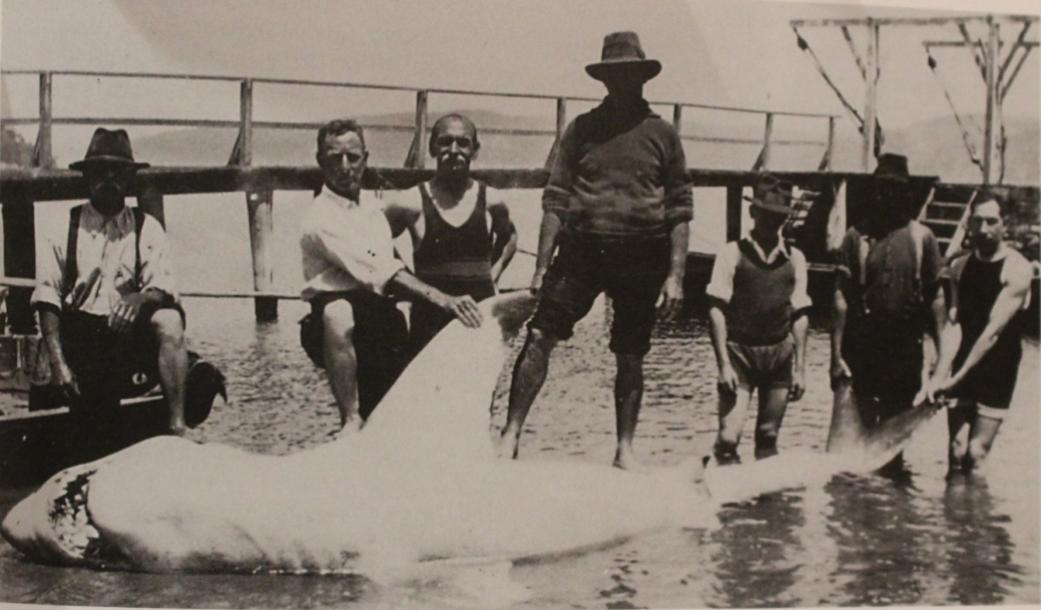
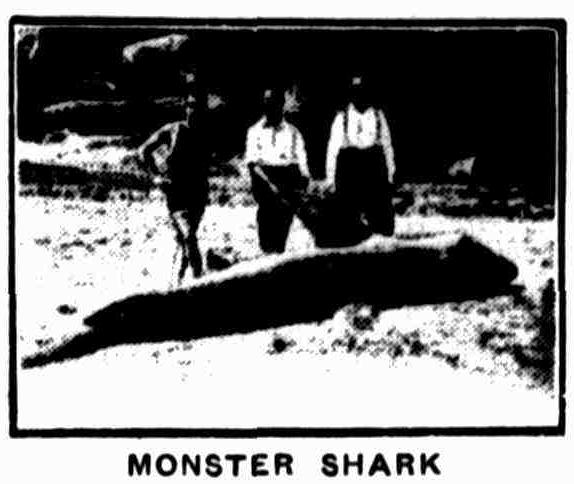
The Goddard men were renowned in Palm Beach SLSC and were firm friends with the other permanent residents, the Gow, Gonsalves and Verrills families. These were the men called by a succession of Barrenjoey lightkeepers when people were in distress at sea - although in these early years the brother and father of Carl Gow were the lightkeepers at Barrenjoey.
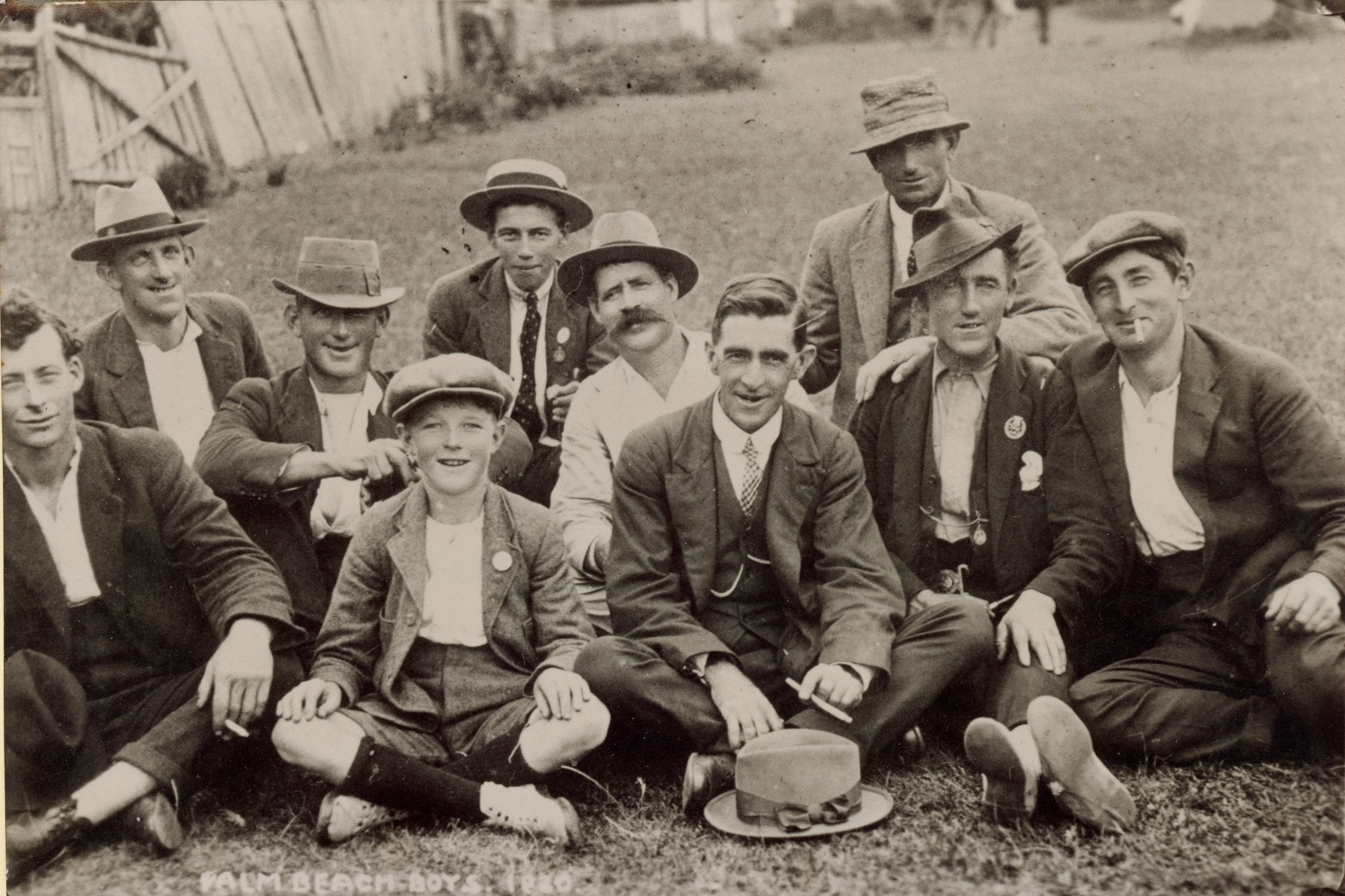
Bert (Albert) Verrills and his building crew in 1920. Back of the photo lists the names of those pictured, from left to right from back to front row, and shows this includes Architect Henry Wilshire (3rd from right), who had so much to do with so many early buildings in Palm Beach, such as Windyridge, atop Sunrise road. Photo: Bill Goddard
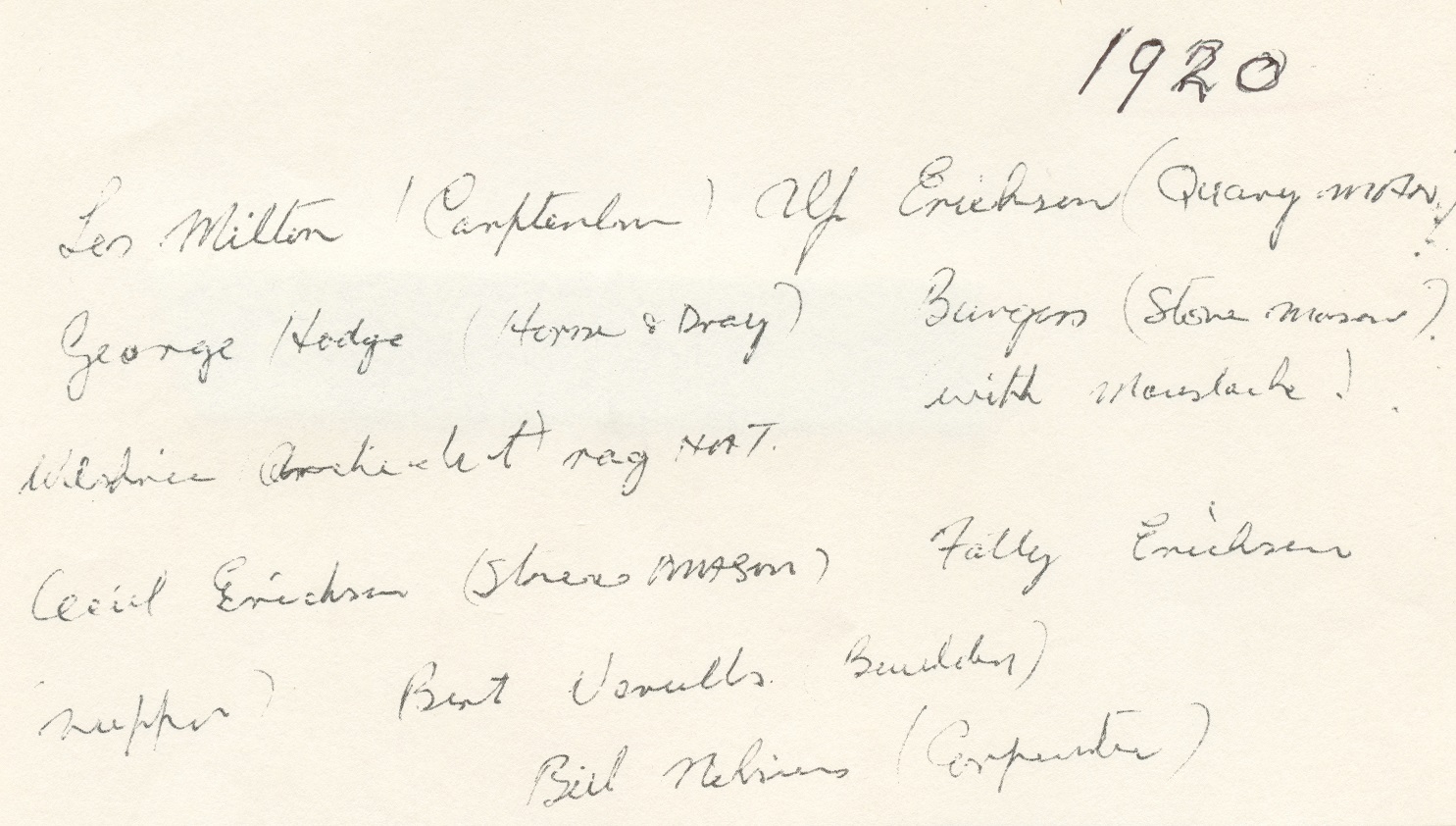
In between escapades rowing up the coast to be part of surf boat races in carnivals and rescue efforts, they built yachts, launches and opened a shop.
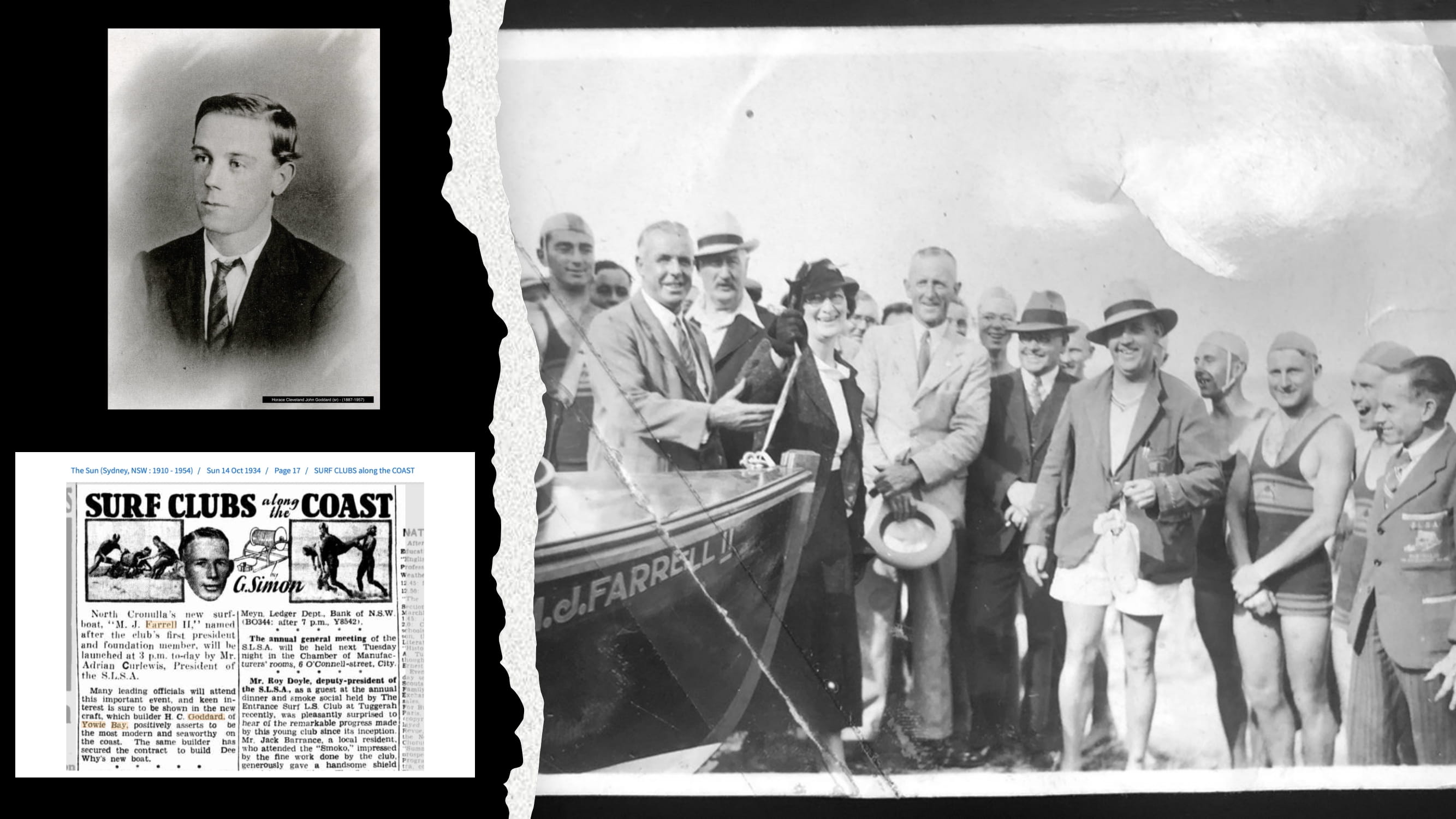
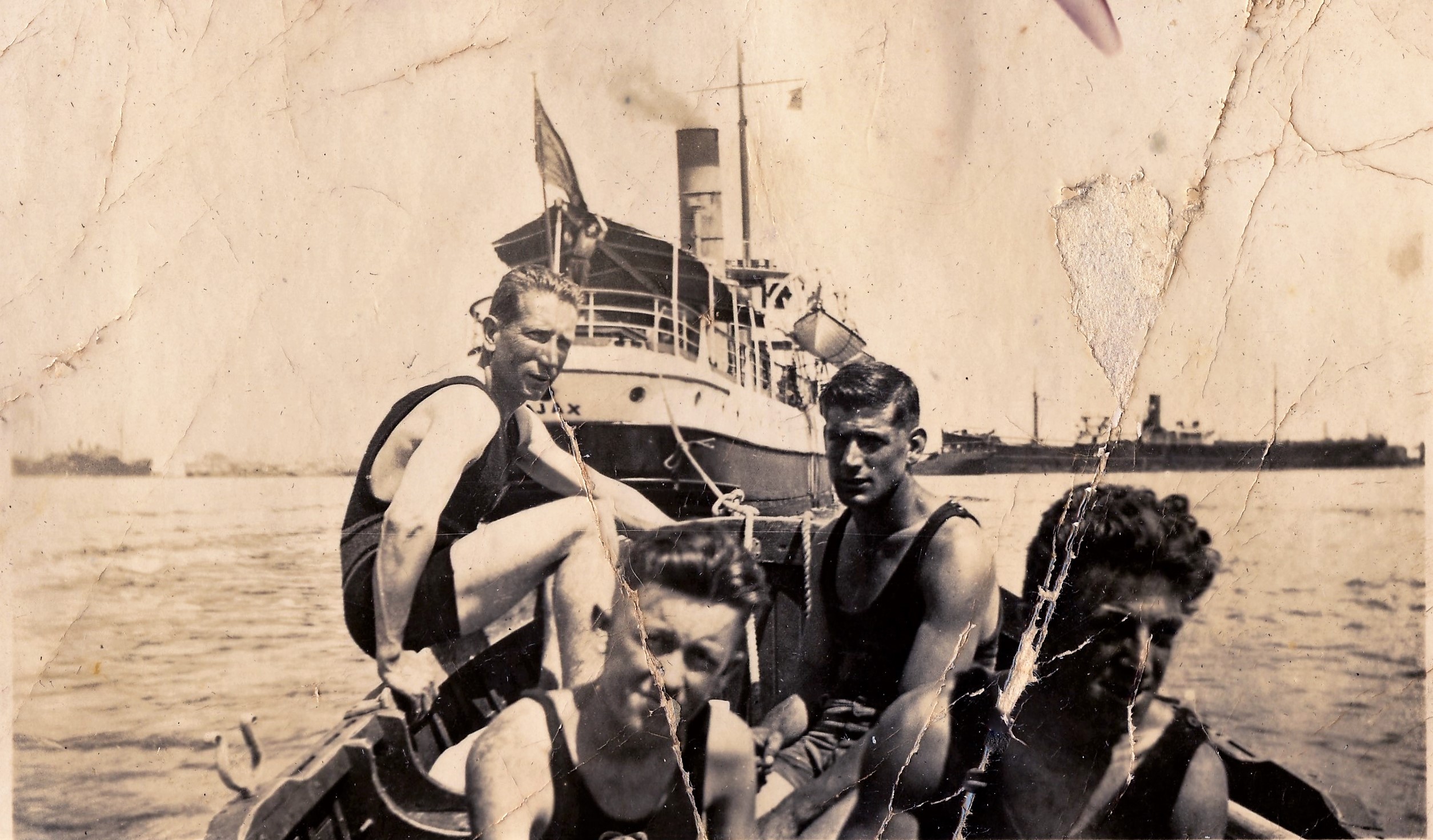
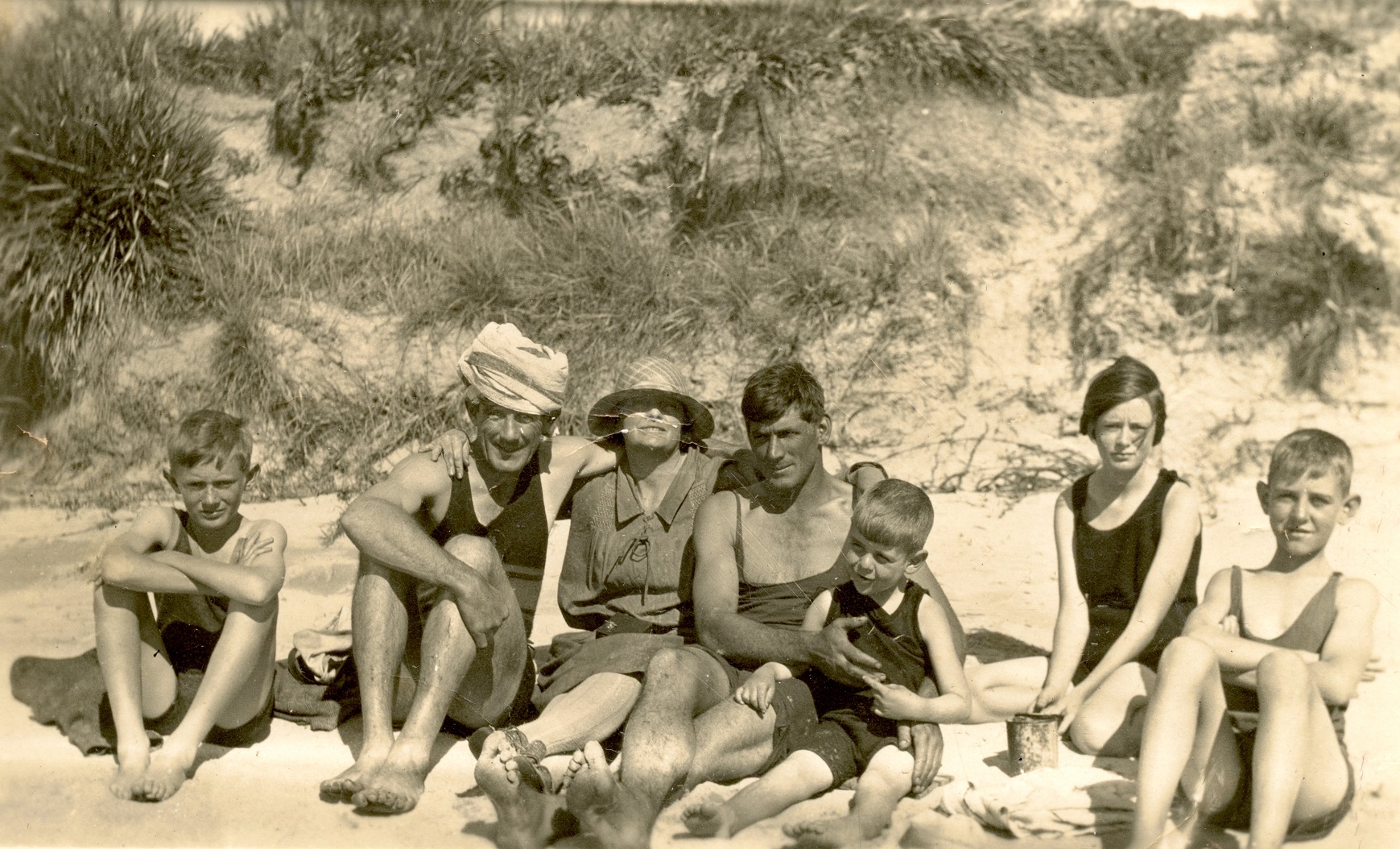

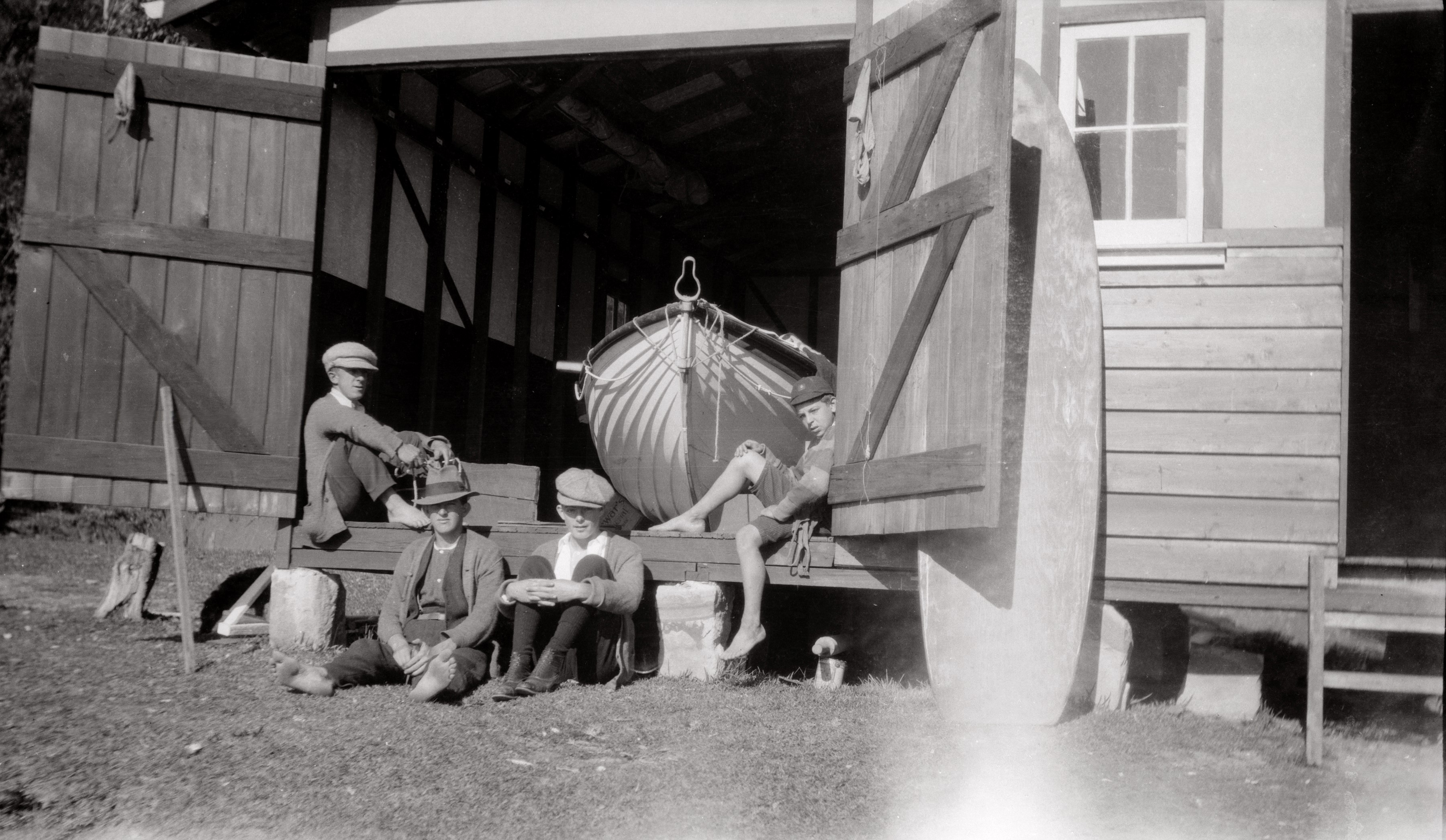
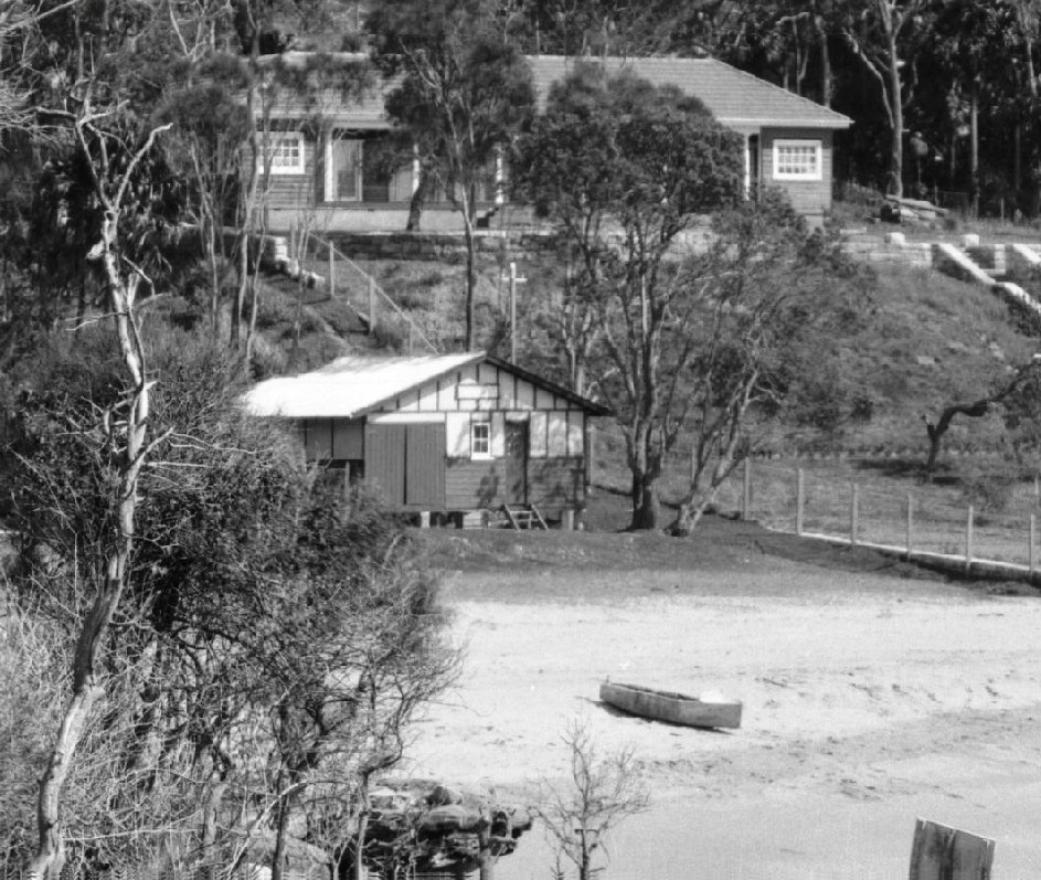

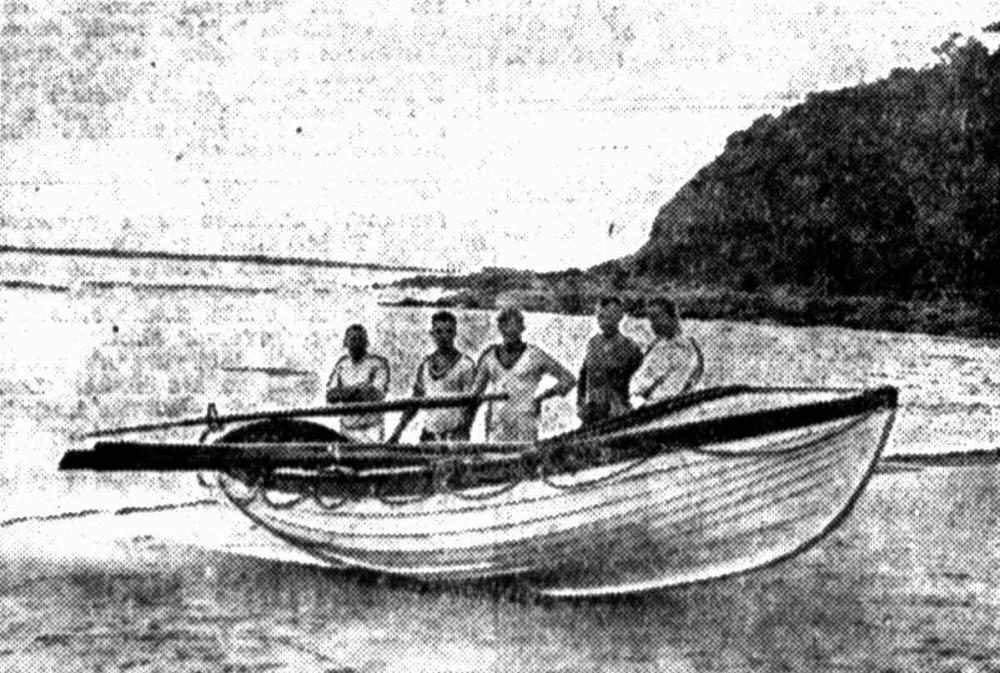
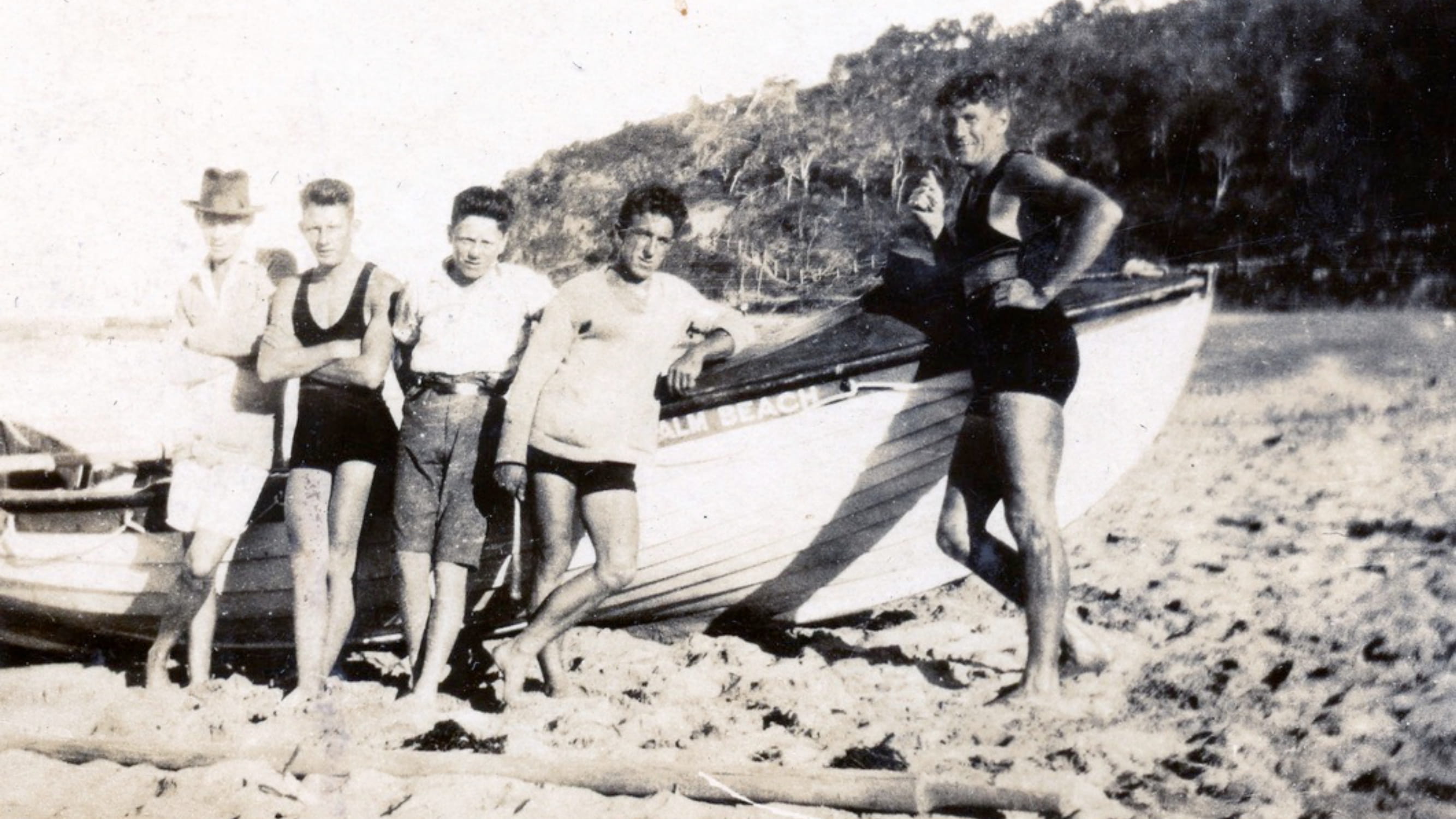
.jpg?timestamp=1664027461887)
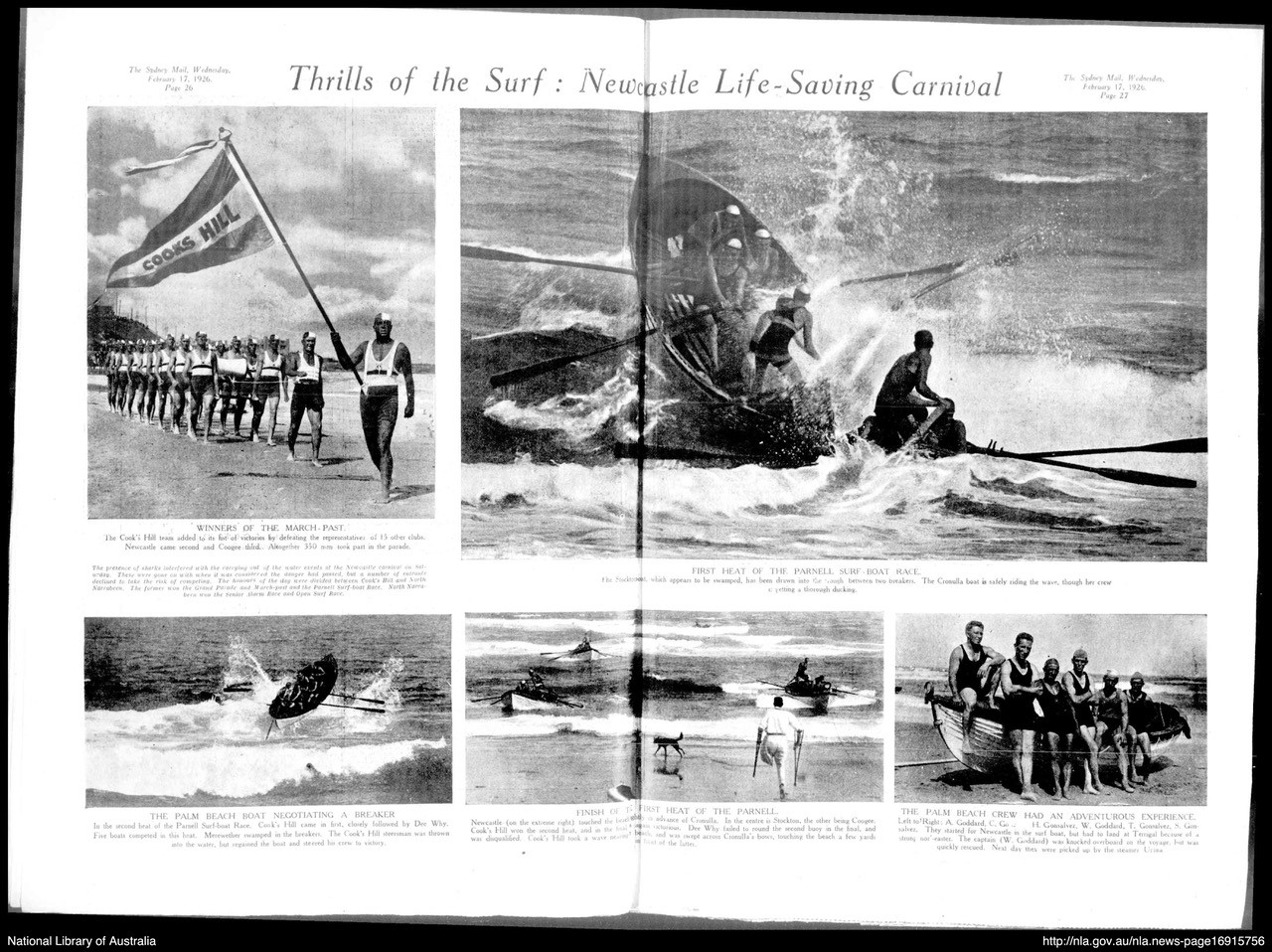
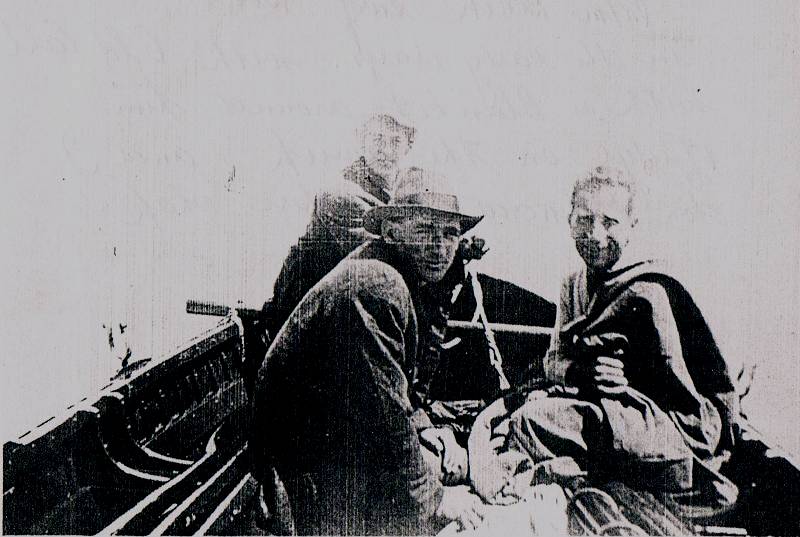
Men's Struggle To Save Yachts. SYDNEY, Saturday.— In mountainous seas which raged off Palm Beach yesterday and last night gallant work was per formed by W J and A Goddard and S. Gonsalves in rescuing two fine yachts which had broken adrift from their moorings. It was not until after midnight that they completed their job. According to eye witnesses it was often touch and go whether they would meet with disaster themselves. In addition to the two yachts a launch broke its moorings and eventually piled up on the sands,. Several small boats were swamped in the storm. Men's Struggle To Save Yachts. (1934, February 3). The Mail (Adelaide, SA : 1912 - 1954), p. 5. Retrieved from http://nla.gov.au/nla.news-article58633285
FISHERMEN RESCUED IN HEAVY GALE. ABOVE: Two elderly fishermen, who refused to give their names, photographed in their launch last night, after it had been towed into the shelter of Pittwater from four miles off Palm Beach, where the craft had been caught in a 50-miles-an hour gale. AT RIGHT: Two of the three rescuers, Messrs. Arthur Goddard (left) and Charles Pritchard. FISHERMEN RESCUED IN HEAVY GALE. (1946, July 31). The Sydney Morning Herald (NSW : 1842 - 1954), p. 1. Retrieved from http://nla.gov.au/nla.news-article17985621 Photo courtesy Peter Verrills.
Chapman Pup Engines, in putt putts for hire, indicates what boatsheds were here:
C. F. Wymark, Church Point. Pittwater. Andy Riddle, Church Point, Pittwater. Carl Gow. Palm Beach. H. Hollowoy, Palm Beach. W. Goddard and Sons, Palm Beach. Advertising. (1936, January 25). The Sydney Morning Herald(NSW : 1842 - 1954), p. 2. Retrieved from http://nla.gov.au/nla.news-article27995816
As fishermen Carl did not always 'stick to the rules' if they found they didn't make sense - as already mentioned by Pete Verrills he was a wise man - both of these incidents were reported nation-wide:
Free Fish
TWO TONS GIVEN AWAY IN SYDNEY
Sydney, March 11.'— A trawler operator, Mr. C. B. Gowe, at Palm Beach to-day gave away more than two tons of fresh whiting. In quarter of an hour hundreds of people swarmed round Mr. Gowe's truck.
Gowe said: 'Because of mismanagement at the fish markets I am unable to market this fish. Rather than dump it at sea, I am giving it away. The price paid to us is sending us broke. The Government is causing chaos in the industry.' Free Fish (1947, March 13). Kalgoorlie Miner (WA : 1895 - 1954), p. 2. Retrieved from http://nla.gov.au/nla.news-article95592010
Fisherman Wins Appeal Against Crown.
The Court of Criminal Appeal decided yesterday that it, is not an offence for a professional fisherman to have in his possession fish irrespective of whether he proposed to sell it in the established market or not.
The decision arose out of an appeal by Carl Beeston Gow. Gow was convicted by a magistrate under the Fisheries and Oyster Farms Act of having fish for sale which had not been brought to and sold in the district market. The fish was seized and forfeited lo the Crown. Gow appealed unsuccessfully to Quarter Sessions. Government inspectors saw Gow's truck in front of a fish shop at Narrabeen. There was a large quantity of fish in the truck, a set of scales, and newspapers.
The Chief Justice, in a reserved judgment, said it clearly would be nonsense to suggest that in all cases the mere possession of fish intended to be sold before they had been sold in a market would constitute an offence.
Every licensed fisherman obviously intended to earn a livelihood by disposing of his catch by selling it. But as soon as he took the fish into his boat or otherwise reduced it into possession then he had it in his possession for sale, not immediately, perhaps, but at some subsequent time. He must then send the fish to the market in order that it might be sold in compliance with the requirements of the Act, and to suggest that the section of the Act was to receive a construction which would make that an offence was clearly absurd.
It was clear that no offence was proved against Gow, his Honor said, because, although he announced his intention of selling some of the fish no sale in fact took place.
The Chief Justice added: "It may possibly be that there is a gap in the Act, but that must be attributed to the language which the Legislature has used, and the Court cannot remould it."
MEANING OF DECISION
A legal authority said yesterday that the practical effect for fishermen of the Court's decision is that a Fisheries inspector will have to detect a fisherman in the act of disposing of his catch outside the legal market before he can be convicted of an offence.
UPHELD
The appeal was upheld with costs.
Mr. Justice Owen and Mr.Justice Herron, in separate judgments, concurred.
[Mr. J. W. Smyth, Q.C.. Mr.G. Carmichael and Mr. A. V. Maxwell (by Bartier, Perry and Purcell) for appellant; Mr. H.A. Henry (by the Crown Solicitor) for the Crown.] Fisherman Wins Appeal Against Crown. (1952, May 3). The Sydney Morning Herald (NSW : 1842 - 1954), p. 4. Retrieved from http://nla.gov.au/nla.news-article18263362
The Gow-Gonsalves Boatshed was the scene of many fund raisers and celebrations at Christmas and Melbourne Cup and a defacto 'Palm Beach RSL' in the years before this was established as a shed near current day Lucinda Park at Palm Beach and finally the RSL we know today under the name 'Club Palm Beach'.
Carl was also among those who worked to establish a kindergarten for local youngsters:
Palm Beach locals establish new kindergarten
Thirty-five Palm Beach children between the ages of three and five years will form a guard of honor when their new kindergarten is officially opened by Mr. P. C. Spender, MHR. on October 3.
"Establishment of this kindergarten is the result of three years' hard work by local residents," secretary and organiser of the Kindergarten Committee, Mrs. Harold Daniell, said. "We are particularly delighted, as it is the first time all Palm Beach residents have been working for one project."
The new building, which will be worth about £3500, also contains a pavilion for the North Palm Beach Surf Club members and a hall which may be rented by other local organisations — the first hall of this type in the district.
Worked in cottage
The children started their kindergarten work about two months ago in a nearby cottage, but are anxious to move into their new building, which has all the latest kindergarten equipment. A full-time trained kindergarten teacher will be in charge, with a domestic assistant. For a nominal fee the children will receive their fruit and daily milk, and, in time, the committee hopes to provide a midday meal cooked in the modern all-electric kitchen. An upright baby grand piano was bought with funds raised for the committee by Mrs. S. Donsalves. A sum of £250 subsidised by the Warringah Shire Council went towards building costs. Members of the management committee include Mrs. Daniell, Mrs. Rudolph Mueller, Mr. C. Gow, and Mr. Frank Savage, who is president of the North Palm Beach Surf Club. Palm Beach locals establish new kindergarten (1948, September 15). The Sun (Sydney, NSW : 1910 - 1954), p. 11 (LATE FINAL EXTRA). Retrieved from http://nla.gov.au/nla.news-article231143495
The kindy at North Palm Beach was duly opened officially on Sunday October 3rd, 1948 – Percy Spender (later Sir), MP for Warringah, had a place at Whale Beach – see The Strand Reserve History page, so possibly the Sunday opening was chosen to coincide with him being at his Whale Beach weekender. NB: the reference of a ‘Donsalves’ would actually be a Gonsalves family member. Mr. C. Gow would have been Carl Gow.
Palm Beach Kindergarten continues as a non-profit Kindy at 1053 Barrenjoey Road, Palm Beach. It remains a community that encourages the involvement of parents and family members; they are all required to attend at least one weekend morning each year to help maintain the centre.
The Management Committee is still a group of volunteer parents who fulfil duties, which assist with the successful running of the Kindy. These positions are filled annually at our AGM and are both rewarding and fun. The Committee consists of: President, Vice President, Secretary, Fundraising Co-ordinator (and fund raising sub committee), Working Bee Co-ordinator, Fundraising Treasurer
Palm Beach kindy has 29 children each day it is open with four staff members looking after them.
It serves as a polling booth during elections, a role it took on after opening that had previously been fulfilled by the Gow's-Gonsalves boatshed and even Barrenjoey House, and remains, in registered name, the ''Palm Beach War Memorial Kindergarten''.
These photos from Tom Gilbert's family albums show him as a tacker and Carl with his own son as well as a fundraising function held at the Gow's-Gonsalves boatshed in 1949 and underline it wasn't just those in the camping reserve that needed a kindergarten.
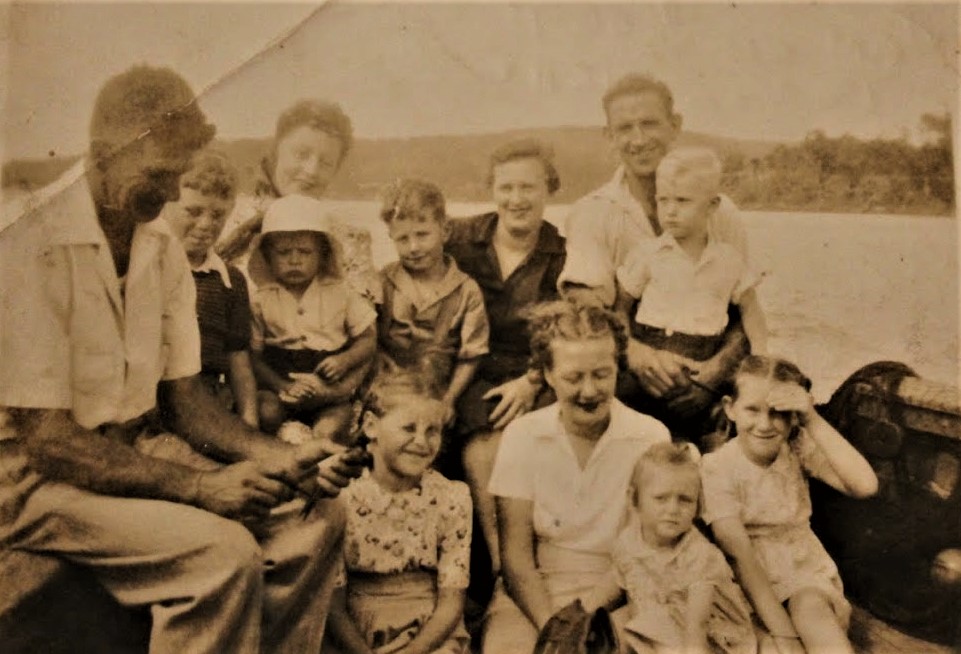
back of photo reads (Carl Gow is at right and back with blond little boy on his lap; source of information; Tom Gilbert):
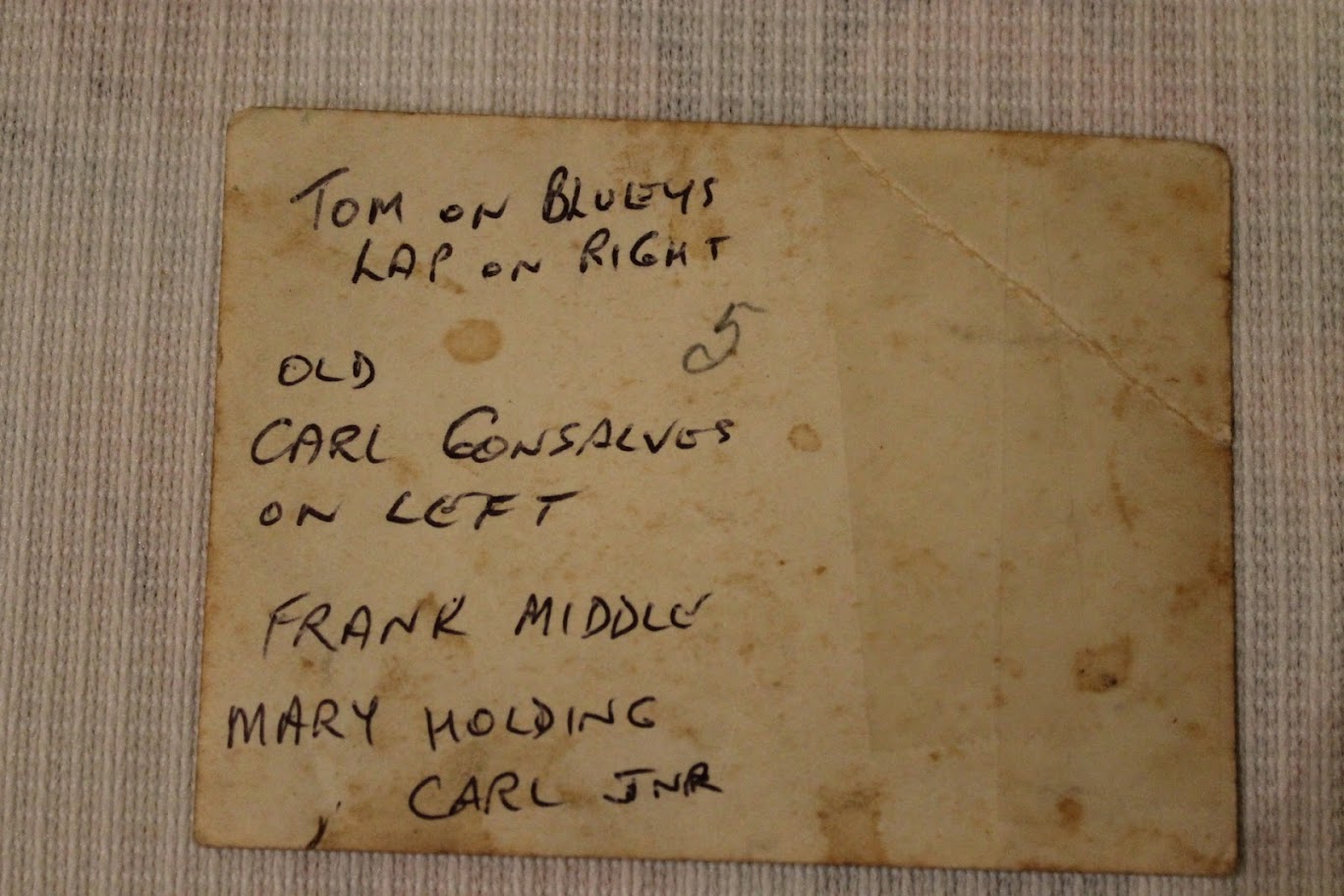
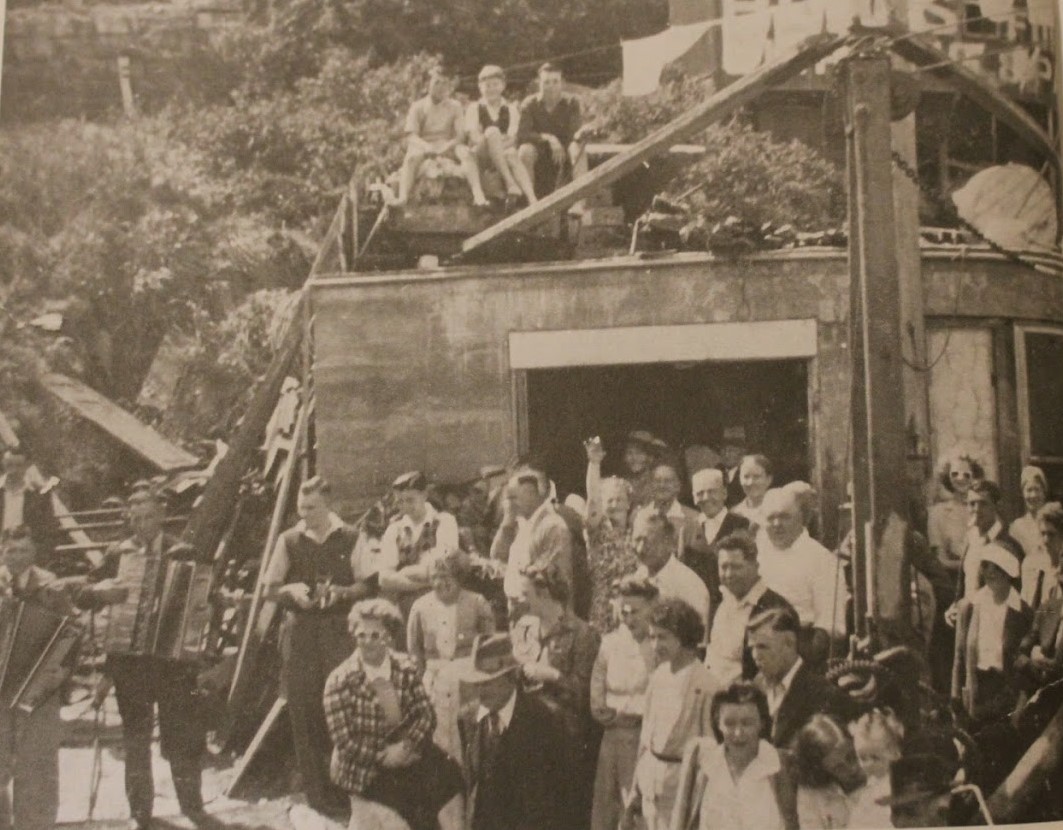 Tom (in middle) atop Carl Gow's/Gonsalves Boatshed, circa 1949.
Tom (in middle) atop Carl Gow's/Gonsalves Boatshed, circa 1949.
HOSPITAL BENEFIT AT PALM BEACH. The Randwick Auxiliary Hospital will benefit from a deep sea fishing and sporting day at Palm Beach tomorrow. Professional fishermen operating from Palm Beach and private owners are providing the trawlers. HOSPITAL BENEFIT AT PALM BEACH. (1950, March 18). The Sydney Morning Herald (NSW : 1842 - 1954), p. 5. Retrieved from http://nla.gov.au/nla.news-article27575067
Carl's smile from the photographs shared by those who knew him, even when he became a white-haired portly gentleman who needed glasses, show he retained a bright twinkle in his eyes and had just decided to get on with life, despite its challenges. Mr Gow was, after all, a man who thought nothing of rowing from Barrenjoey to Newcastle to take part in a SLS Boat Carnival once he did get home and became part of the permanent Palm Beach community.
He was truly a Honorary Captain both on land and at sea, even if he conducted himself quietly, not seeking to attract attention to his methods and endeavours.
It's a pity there isn't something in the Palm Beach landscape to record some of his many feats on behalf of the Pittwater community and Palm Beach in particular.
Nevertheless, residents continue to benefit from his legacies, from 1915 on, while those who were privileged to know him still speak of his spirit and nature, which serves to warm the senses and clear the mind of we who came afterwards with practical good sense, especially when ''the rules'' are just not working.
We would be remiss to think that Carl Beeston Gow is not serving us all still.
Thank you for your service Mr. Gow - and for coming to, and staying, in Pittwater.
References - Extras
- Carl Gow’s WWI Service in AIF - early version
- Palm Beach Jetty - Gow's Wharf
- Carl Gow’s WWI Service in AIF
- Carl Gow and Frank Gonsalves Boatshed, Palm Beach
- Palm Beach Link With 1817 and 1917 Set to Disappear in 2017: Beach Road Rendezvous
- The Fearless Men of Palm Beach SLSC's Surf Boats First Crews - A Tale of Viking Ships, Butcher Boats and Robert Gow's Tom Thumb 'Canoe
- Light Keepers of Barrenjoey Lightstation
- Pittwater Fishermen: Barranjoey Days
- Peter Frederick Verrills
- Tom Gilbert
- William James Goddard (III - or jnr. - or 'Bill') shares family insights at Avalon Beach Historical society's 2022 AGM
Carl Beeston Gow
Recommendations (Medals and Awards) - Military Cross
Recommendation date: 11 November 1916 - Mention in Despatches
Recommendation date: 20 September 1917 - Military Cross
Recommendation date: 8 March 1918 - Mention in Despatches
Awarded, and gazetted, 'London Gazette', second Supplement, No. 30448 (28 December 1917); 'Commonwealth Gazette' No. 57 (18 April 1918).
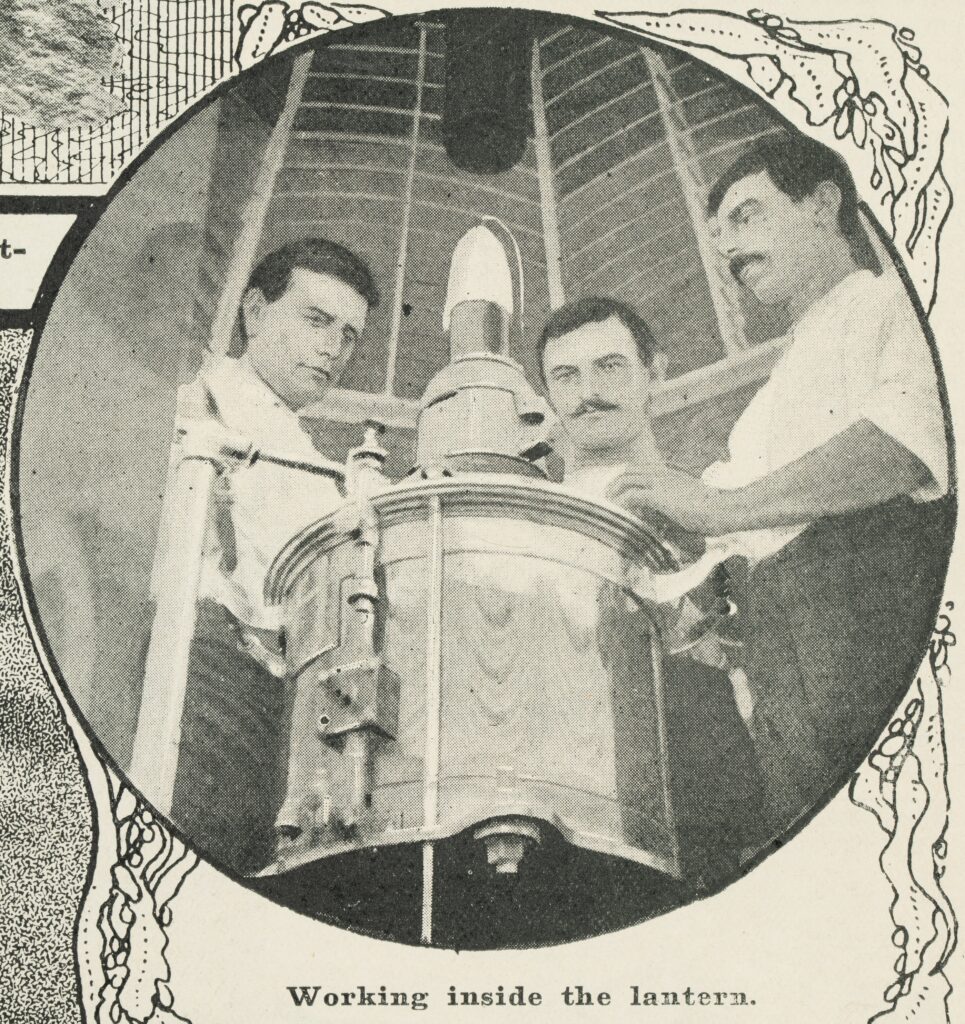
Lightkeepers David Gow, John Fisher and Ralph Robinson; South Solitary Island (1912, February 28). Australian Town and Country Journal (Sydney, NSW : 1870 – 1919), p. 21. http://nla.gov.au/nla.news-article263733370
A PATRIOTIC POEM
Private J. Allen, late of Bunbury, W.A., now of C Co., 11th Battalion.3rd. Brigade, 1st Australian Division A.I.F., Mena Camp, Egypt writes : — "Editor 'The Sunday Times, —Enclosed are a few verses written by myself on Christmas Day. Should you think them lit for publication you are at liberty to use them."
The verses, which in sentiment at least leave nothing to be desired, are given hereunder : —
CHRISTMAS DAY IN EGYPT. 1914
Christmas Day in far-off Egypt,
Out on the burning plain
We are thinking of home and dear ones
We ne-er may see again.
We are eating Christmas dinner.
But our minds will not cease to roam
To that far-off land Australia.
That we're proud to call our home.
We have bully beef and biscuits
On which our teeth will ring;
But we must not growl or grumble.
For we're soldiers of the King.
The major has just shouted
Good old Christmas beer.
And wished us joy and plenty
To carry us through the year.
"I've a cable from Australia,"
Said the colonel on parade
"I received it yesterday.
And this is what it said :
"Australia's proud to greet you
On this our Christmas Day.
And hope you'll spend it merrily
In the good Australian way."
But still our hearts will wander
To wives and sweethearts far away.
And wishing we were back again
With them to spend the day.
But now that we are soldiers
We always must "stand by,"
Ready for any emergency,
Ready to do or die.
For the Motherland's in trouble,
And it is no idle boast ;
We'd rather die than be the slaves
Of the mighty German host.
But God will see us safely through
Until the day is won ;
And John Bull will whisper to us —
"Australia's sons, well done !"
A PATRIOTIC POEM (1915, February 21). The Sun (Kalgoorlie, WA : 1898 - 1929), p. 16. Retrieved from http://nla.gov.au/nla.news-article211341505
ANZAC
The Cornstalk found it sultry
When he went to fight the Turk,
But, hot with indignation, he
Was warming to the work;
At first he shed his khaki coat,
And then he sloughed his vest,
Then, getting down to Nature's -self,
He stripped his manly chest;
He seldom wore his boots at all,
Bare-footed he would go,
He said he wasn't needing socks —
He'd give 'em to the foe!
His trousers he cut down to shorts,
And, nearly naked then,
The Turk looked on the Cornstalkers
And saw that they were men!
They are handy with the rifle,
And their big guns drop "some"
shells,
They can do a lot of spade-work
In the 'Nelles — the Dardanelles;
And the Turk he shakes his solemn
head,
And each to t'other tells
That they wish those big Australians
Hadn't come unto the 'Nelles —
For it's shells and yells and little hells
In the Darda-Dardanelles!
Now the Cornstalk has a brother,
Who's the big New Zealand kid;
He came to help the contract —
Turkey's sorry that he did;
He arrived without a welcome,
And they wished he'd go away,
But he planked his foot down on the
shore
And said he'd come to stay.
He's got a mighty fist on him —
Heaven help the Turk he biffed!
They tried to blow him back agin,
But found he wouldn't shift;
His feet thoy don't turn backwards —
'Tis a route he's never gone,
The more they try to push him out,
The more he pushes on;
He says he doesn't like the Turk,
He's nasty, and he smells
There's be sweeter air without him
In the 'Nelles — the Dardanelles;
And so he hunts the vermin
On the cliffs and in the dells,
In time with gentle Lizzie's voice
That screeches from the 'Nelles —
Oh, the shells and yells make little hells
In the Darda-Dardanelles!
You put the two together,
As a couple they're a treat,
Hard as nails and tough as leather,
Too deuced hard to beat!
They've settled down in Turkey,
For with steel they pegged a claim,
They have christened their now country,
And "Anzac" is the name —
Which stands for that Australian
And that New Zealand chap,
A name they made up in their heads —
It wasn't on the map.
But now, by gum! it's written there
In blood, and will remain;
A new name, printed deep, no Turk
Will e'er erase again!
Let us remember Anzac
And the glorious tale it tells,
How Britain from the Overseas
Came to the Dardanelles —
To the shells and yells and little hells
Of the Darda-Dardanelles!
— "John Bull."
ANZAC (1915, December 4). The Bathurst Times (NSW : 1909 - 1925), p. 4. Retrieved from http://nla.gov.au/nla.news-article111252278
Cornstalk: 1. Australia, slang, obsolete; A non-indigenous person born in Australia. 2. (Australia, slang, derogatory) a non-indigenous native of New South Wales.
The nickname "cornstalk" for Australian-born people was not coined by John Milton Wentworth. It was a colloquial term that emerged in the 1820s, referring to the perceived height and lean build of Australians compared to British-born migrants. The term "cornstalk" stuck as a way to distinguish the Australian-born from the British-born, who were sometimes referred to as "Sterlings,".
John Bull:

John Bull, World War I recruiting poster, c. 1915
British recruiting poster produced by the Parliamentary Recruiting Committee. Depicts John Bull, resplendent in a Union Jack waistcoat, pointing at the viewer. Behind him is a group of buildings on fire, and a line of khaki-uniformed British soldiers.
''BARONET JOHN BULL."
A TYPICAL ENGLISHMAN.
LONDON, October 12.
The death is announced in London of Sir Oswald Mosley. He was known as Baronet John Bull'' on account of his resemblance to the conventional pictures of John Bull, and the fact that he dressed the part.
Sir Oswald Mosley, who was the fourth baronet, was born in Staffordshire on September 25, ISIS. The title was created in 1759. He was educated at Eton, and travelled in all parts of Europe for three years with a tutor. Sir Oswald owned 3,800 acres of land, and he was a breeder of Shorthorns. He was also a practical farmer and a gardener on an extensive scale, and he had a museum of British birds. His seats were Rolleston Hall, Burton-on-Trent, and ,Abing\vort"i, Sussex. He married a daughter of Sir William White, and his only son succeeds to the baronetcy. "BARONET JOHN BULL." (1915, October 13). The Advertiser (Adelaide, SA : 1889 - 1931), p. 12. Retrieved from http://nla.gov.au/nla.news-article5483701
AFTER ANZAC.
Thus Sergt. Chas. Mcintosh to his parents : —
' Of course you will have heard about the evacuation of Anzac before this. We were very comfortably housed and cared for there. Here, at Lemnos, all is peace and rest. When I say we had nothing better than salt water for 25. weeks you will understand how we appreciated a bath in water about as hot as one could stand it, and plenty of soap, followed by a dinner of fish, mutton and potatoes, biscuits and coffee. The island is all hills and dales, agricultural, though not very fertile looking, and now has the bareness of winter. All the farms are small and unfenced. The hills are volcanic and quite without tree or scrub. In the valley they grow grain, and on the hillsides are small flocks of sheep (always shepherded). people apparently poor, plain peasants, living mostly in villages. The cattle are small, a rough sort of Highland shorthorns. Ploughs and other implements rudely made. One old Greek insisted on my ploughing a furrow for him, result rather serpentine. Some small ponies here, but mostly donkeys. Good many fowls, healthy looking, seem to be a cross of most of the Mediterranean tribes. Eggs 3/- a dozen. Greeks running all the canteens and things very dear, but mostly fair quality. Oranges and mandarins (very welcome) 1d each. But the best feature of all is that we have a splendid water supply about 500 yards distant. Christmas weather was perfect, bright, warm sunshine all day, mild night. You'll be sorry to hear I didn't get 'your billy.' Ours came from South Australia, evidently not time to sort them, owing to altered arrangements. My billy was well stuffed: pipe, tobacco, cigarettes, cards, testament, lollies, etc. Several chaps got mouth organs and yesterday morning the camp sounded like at Xmas at home. At sea. 31/12/'15. En route for Alexandria, and the sea as smooth as glass. Stayed at Lemnos just two weeks, weather delightful nearly all the time. Cecil Hughes is in Dudley Hospital, Birmingham. We have arrived at the wharf after a safe and enjoyable run.' AFTER ANZAC. (1916, February 26). The St George Call (Kogarah, NSW : 1904 - 1957), p. 5. Retrieved from http://nla.gov.au/nla.news-article162770125
The first Anzac Day Services took place on April 25, 1916:
ANZAC DAY.
At St.. Thomas Church, on Tuesday next, on the anniversary of the heroic landing at Gallipoli, special services will be held. Holy Communion at 8 o'clock and 11 o'clock, and at the evening service, 8 o'clock. a special address will be given. ANZAC DAY. (1916, April 20 - Thursday). The Essendon Gazette and Keilor, Bulla and Broadmeadows Reporter (Moonee Ponds, Vic. : 1905 - 1924), p. 3 (Morning.). Retrieved from http://nla.gov.au/nla.news-article74592676
ANZAC ALPHABET.
A stands for Anzac, where landing first was made,
By boys from Southern Hemisphere, whose lives they dearly paid.
B stands for Bacon, another name for pig,
The sappers all enjoy it before they pick and dig.
C Constantinople, a place not far away ;
Our General has told us we'll be the Xmas Day.
D is for Destroyer, that does so much of harm,
And fires a little pop-gun, and causes Turks alarm.
E we give to "Emden," that sank a few small boats ;
Thanks for H.M.S. " Sydney," that tub no longer floats.
F for the land of Freedom, Australians know it well,
And when they see the wattle, they'll have a lot to tell.
G for quite a number of places that we see—
Our gaze is mostly centred upon Gallipoli.
H for Heliopolis, a city of sun ;
Where infantry in training can have some jolly fun.
I we give to India, whose troops have done their bit,
And landed here in thousands, and made poor Jacko flit.
J for that great General called Joffre, you'll all agree,
He frightened quite a number of men in Germany.
K stands for Kitchener, Britannia's man of fame,
He'd worked to the uttermost to free this world of shame.
L stands for Lemnos, an island, I'm told,
That's worth to us as British more than a mint of gold.
M stands for Mutton, of which we never see ;
It's bully beef for breakfast, and bully beef for tea.
N is for our Navy, that sweeps the ocean wide,
Regardless of the currents, regardless of the tide.
O is for Opinion, which you are free to form,
It may be as cold as blazes, you'll argue it is warm.
P stands for Piastre, a coin and racehorse, too ;
For money and for pleasure, you cannot beat the Jew.
Q for Quartermaster, who deals out all our stores,
And gives us dainty biscuits, with which to break our jaws.
R is most important : it's Rum it stands for here ;
The soldiers all enjoy it, because they cannot get the beer.
S stands for Sickness : the soldier has his share ;
He needs a lot of nursing ; he needs a lot of care.
T stands for Turkey, a good old Christmas dish ;
To have it in Australia was many a longed-for wish.
U is for the Back-sight we look through when we aim ;
It's used for shooting " Jacko" or any other game.
V is for Victorious : I hope we soon shall be ;
It's marvellous what a number have gained the famed V.C.
W stands for Whisky, which never comes to light,
No matter if you battle and work from morn till night.
X is for the Crosses against old "Kaiser Bill" ;
If he don't soon surrender. I'm afraid he never will.
Y is just a Query—When shall we all get back ?
Z answers : " When the fighting is finished at Anzac."
The above was written by Sapper C. Ingleby, of the Australian Engineers. It was written at Steel's Post, Gallipoli. ANZAC ALPHABET. (1917, February 3). Heidelberg News and Greensborough, Eltham and Diamond Creek Chronicle (Vic. : 1916 - 1918), p. 3. Retrieved from http://nla.gov.au/nla.news-article89078371